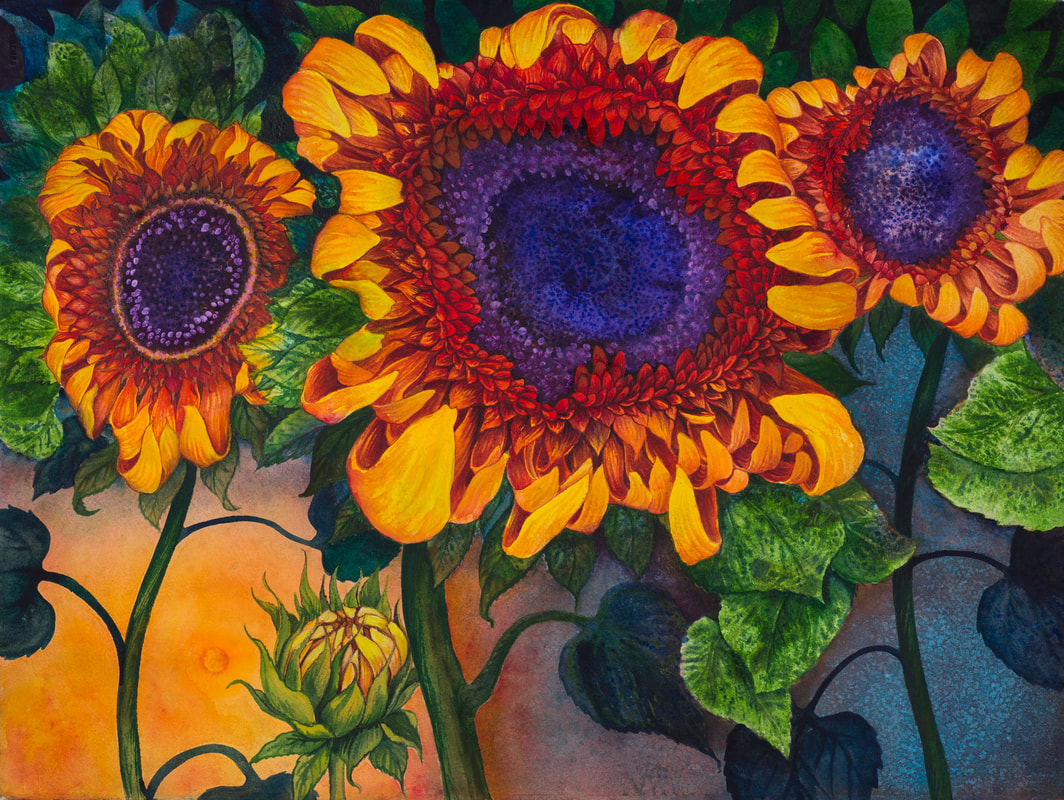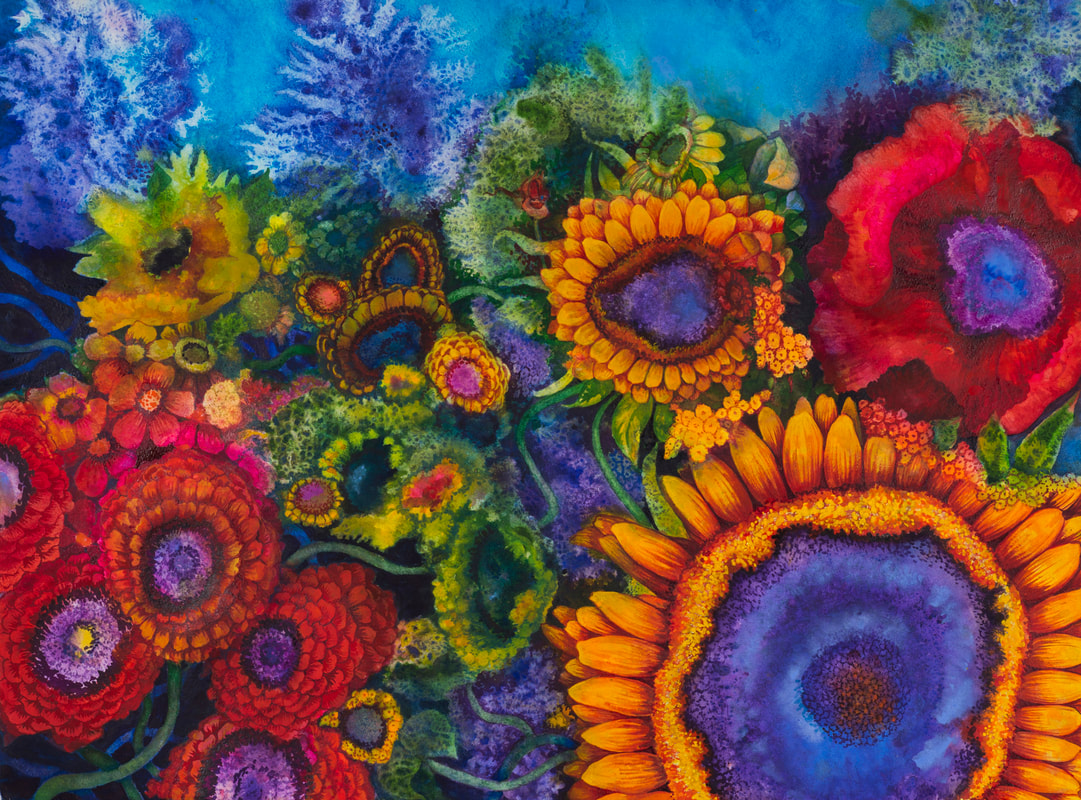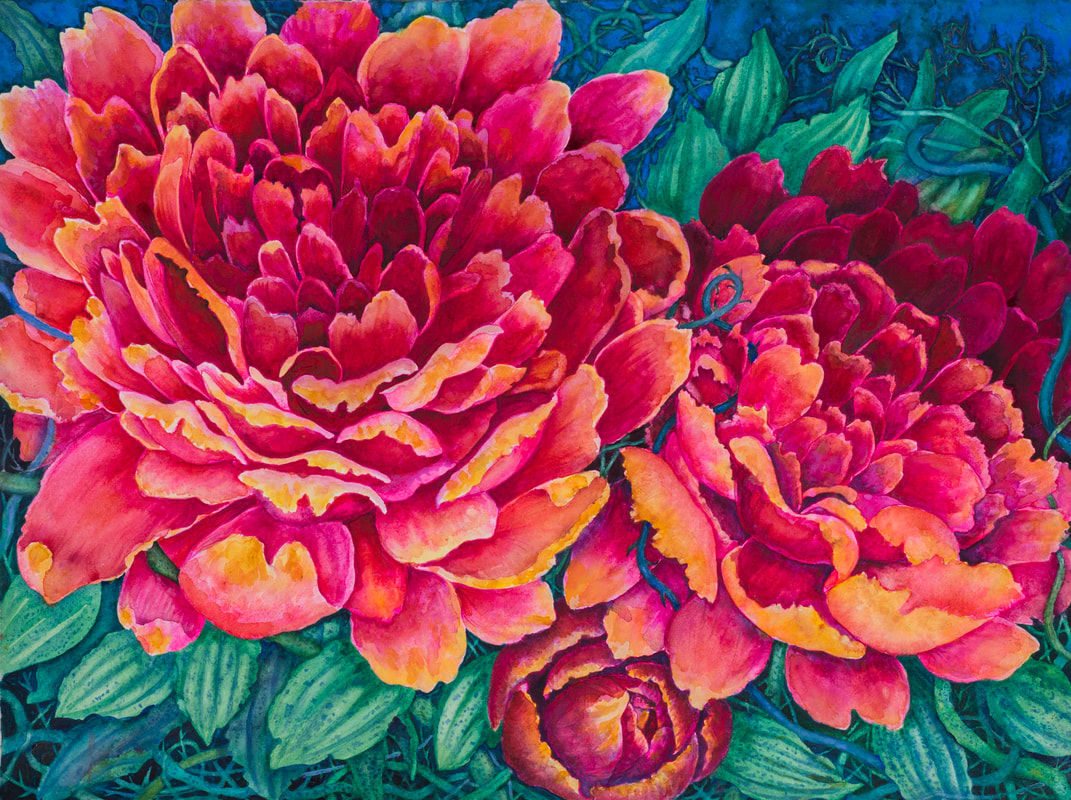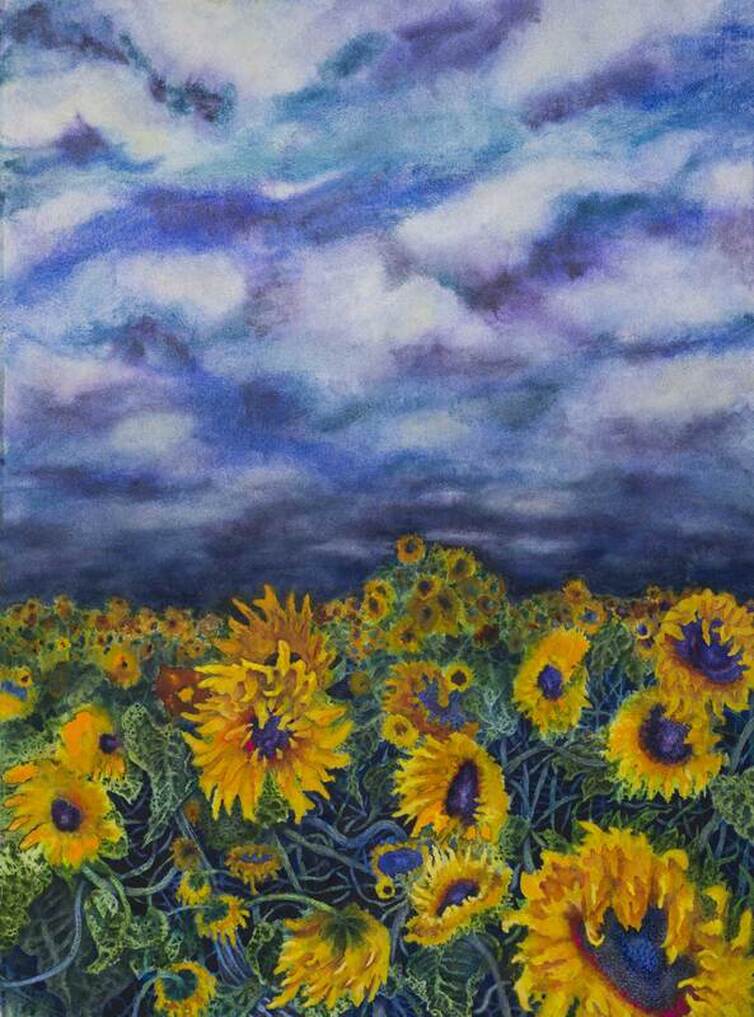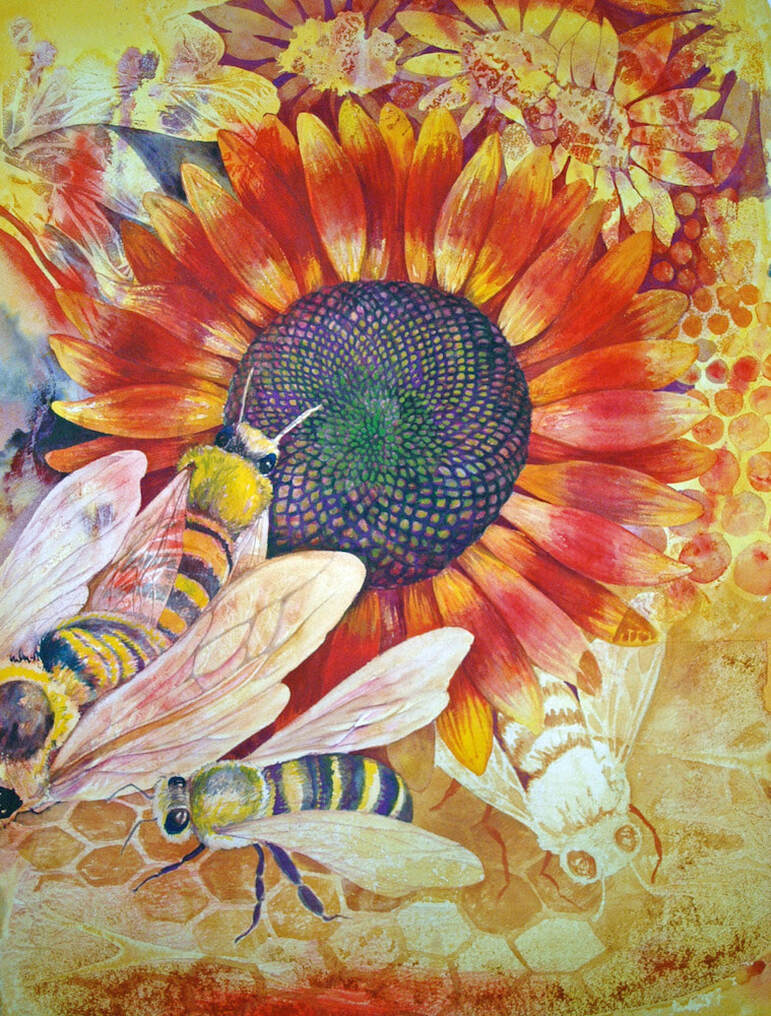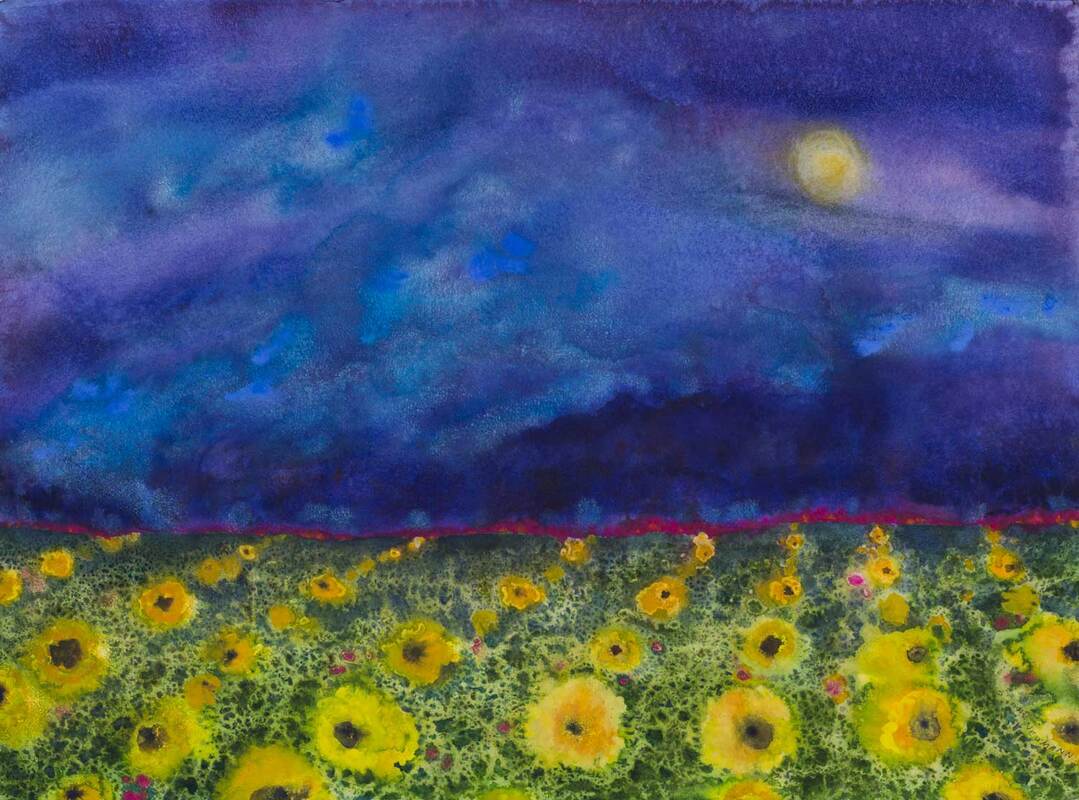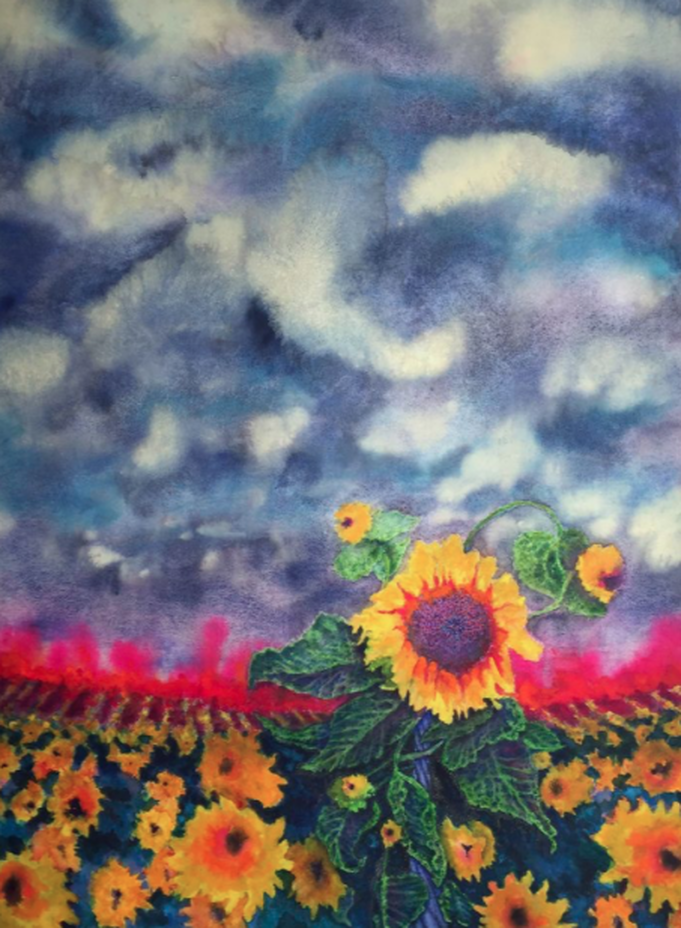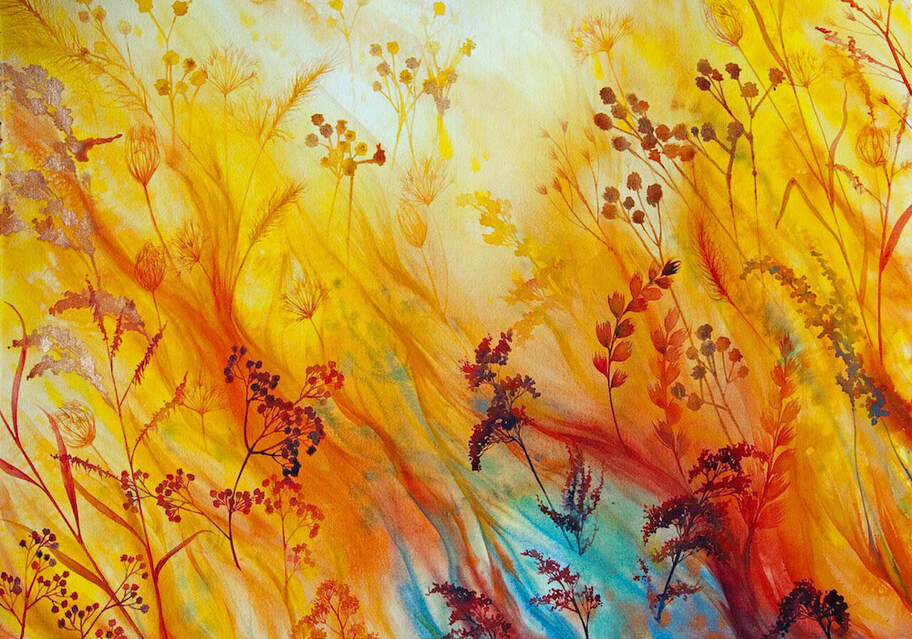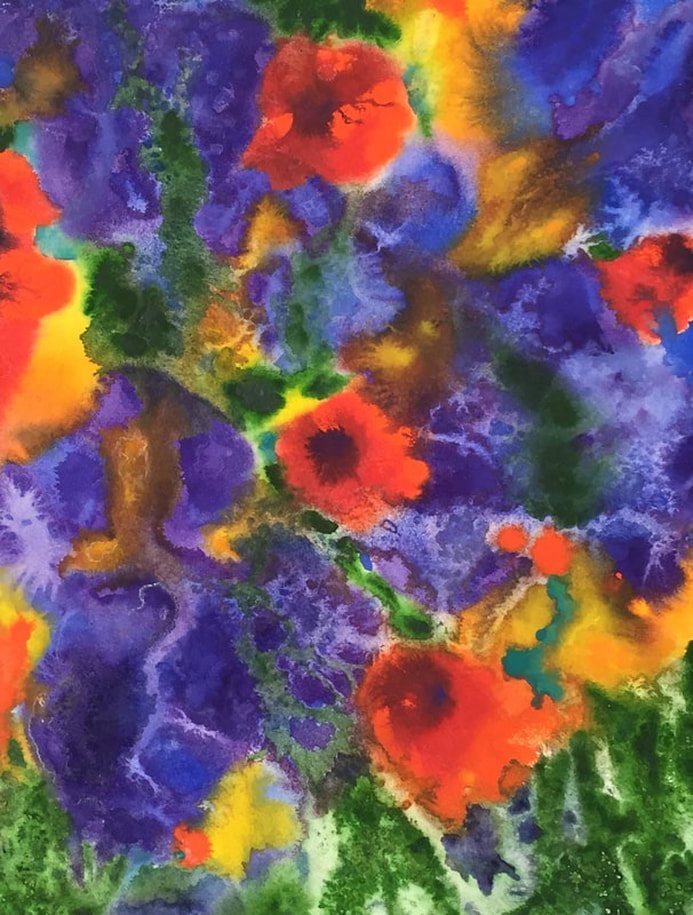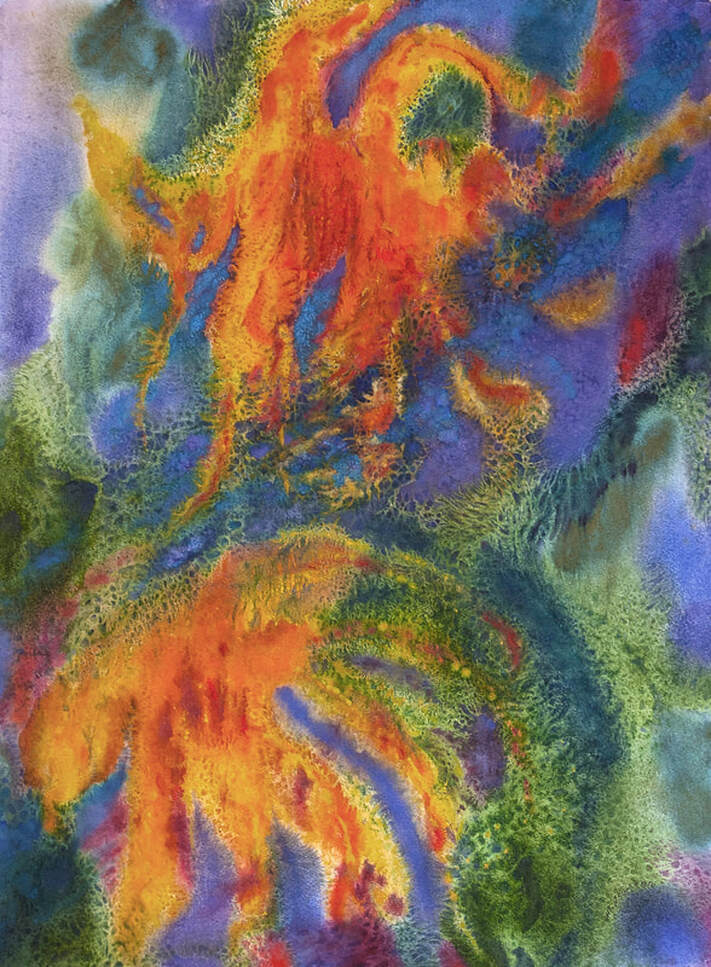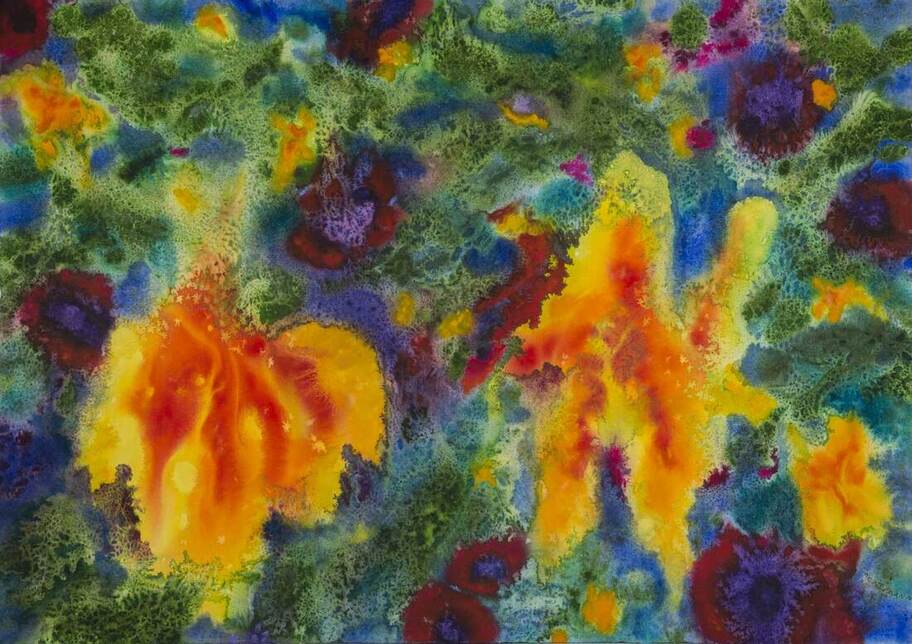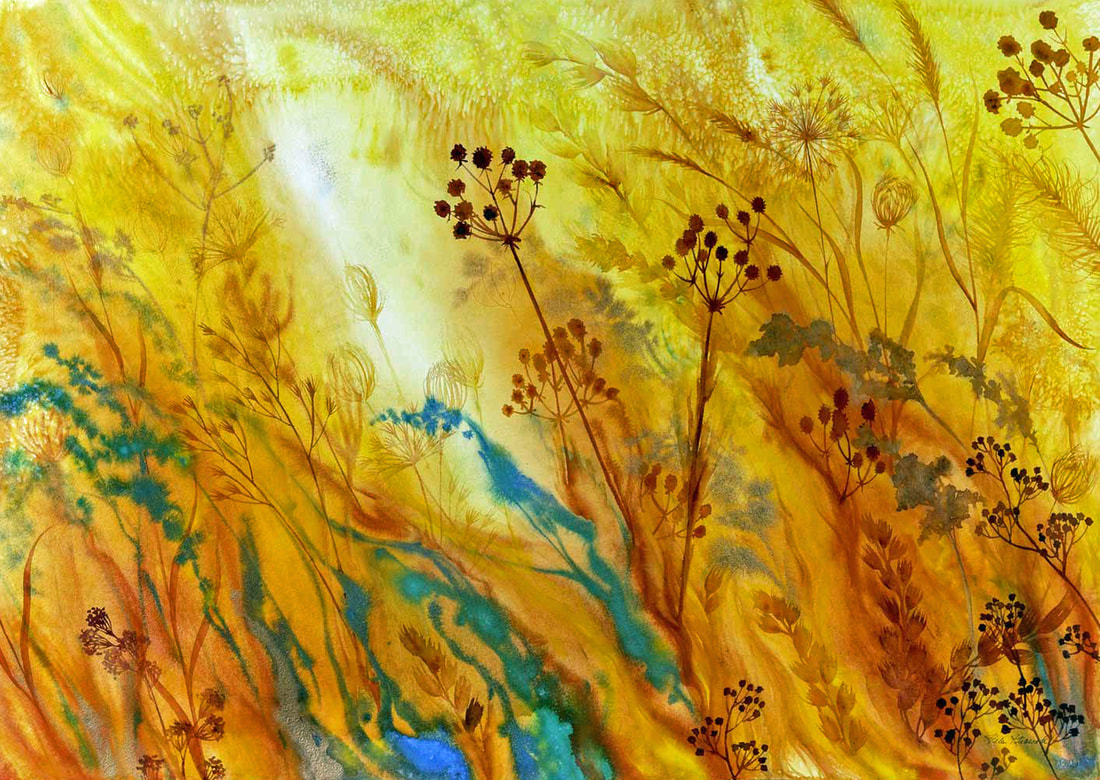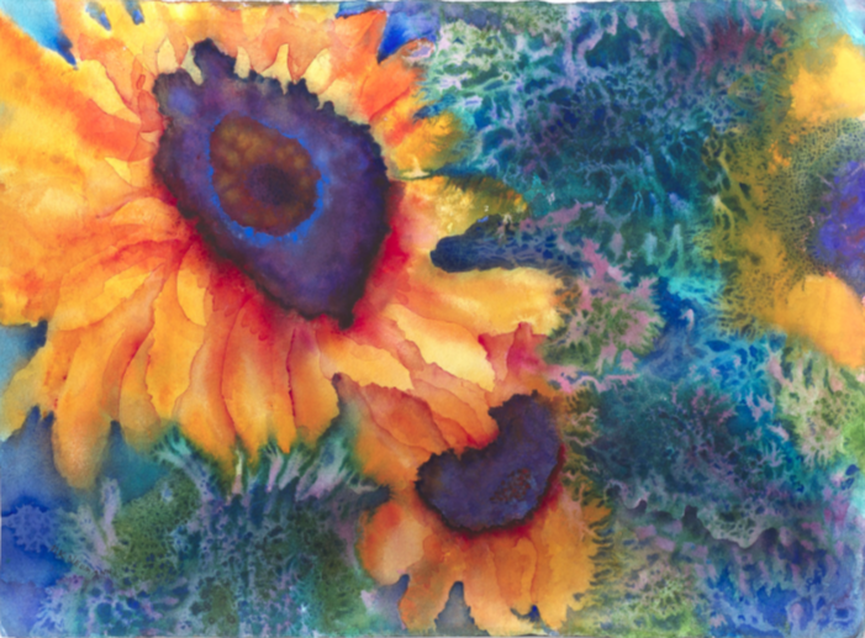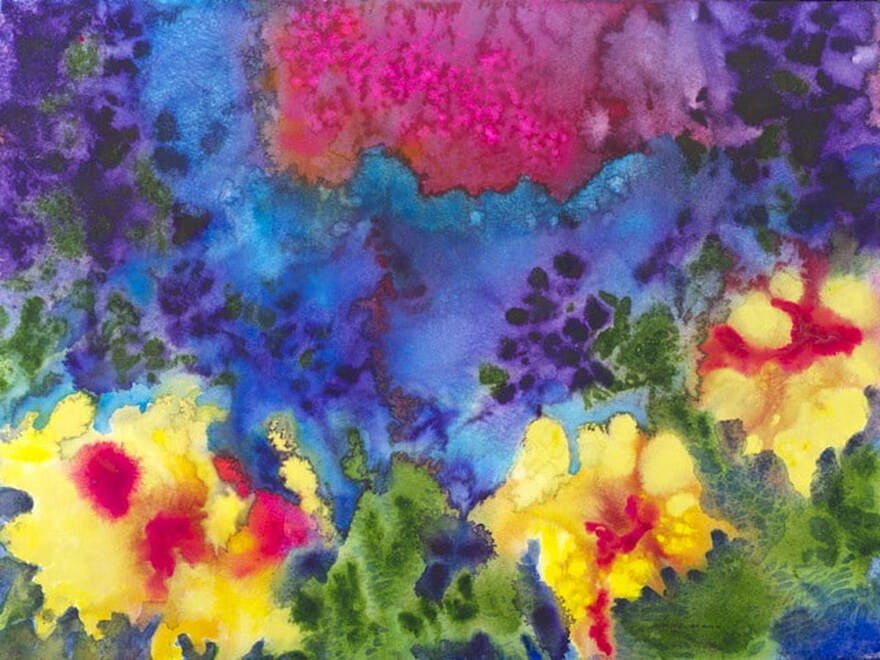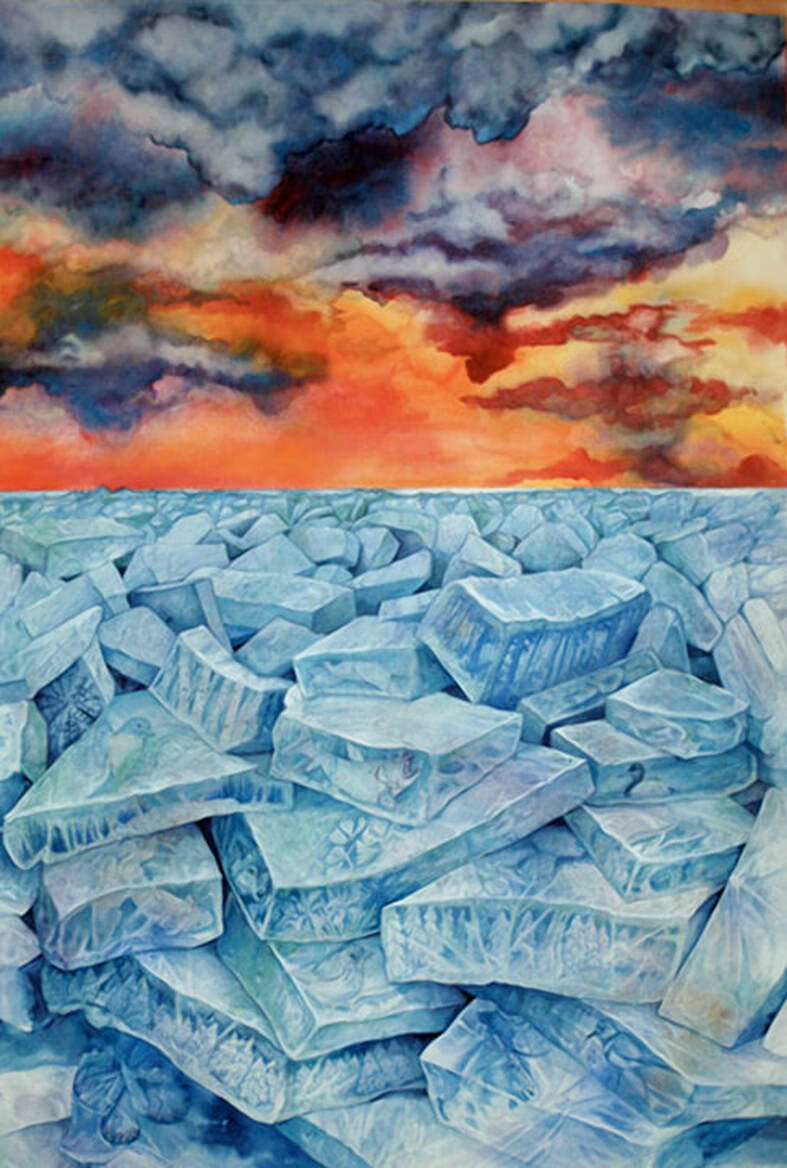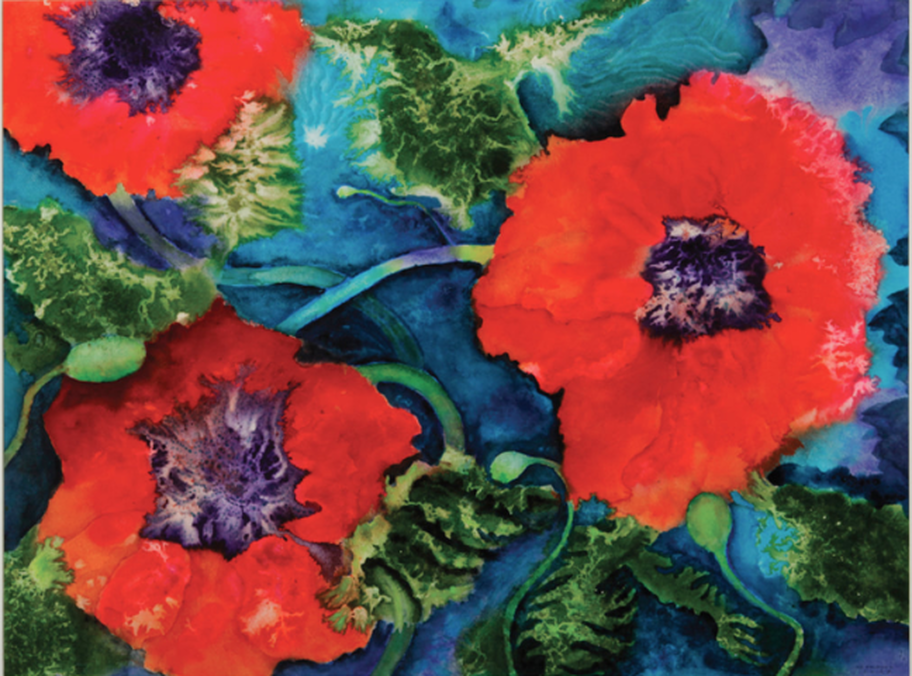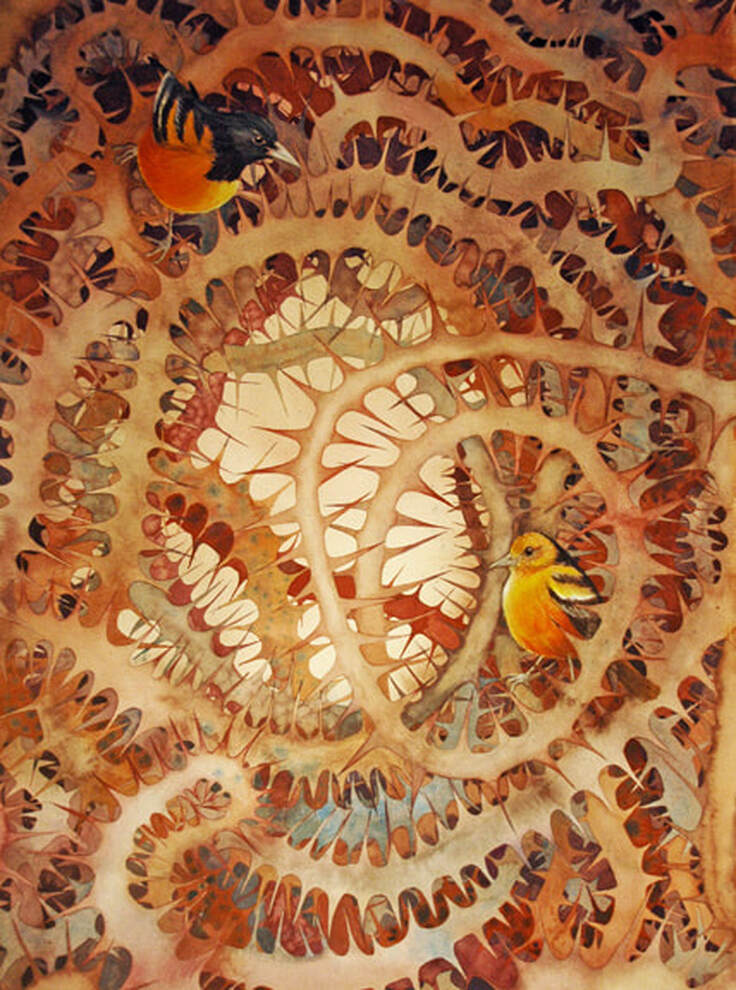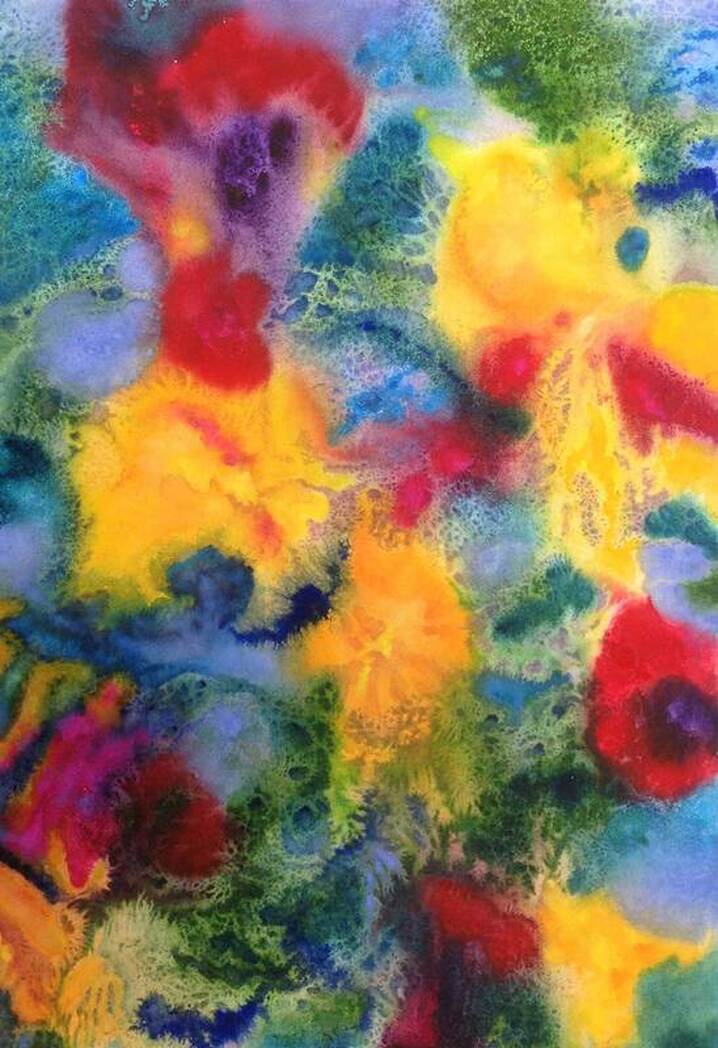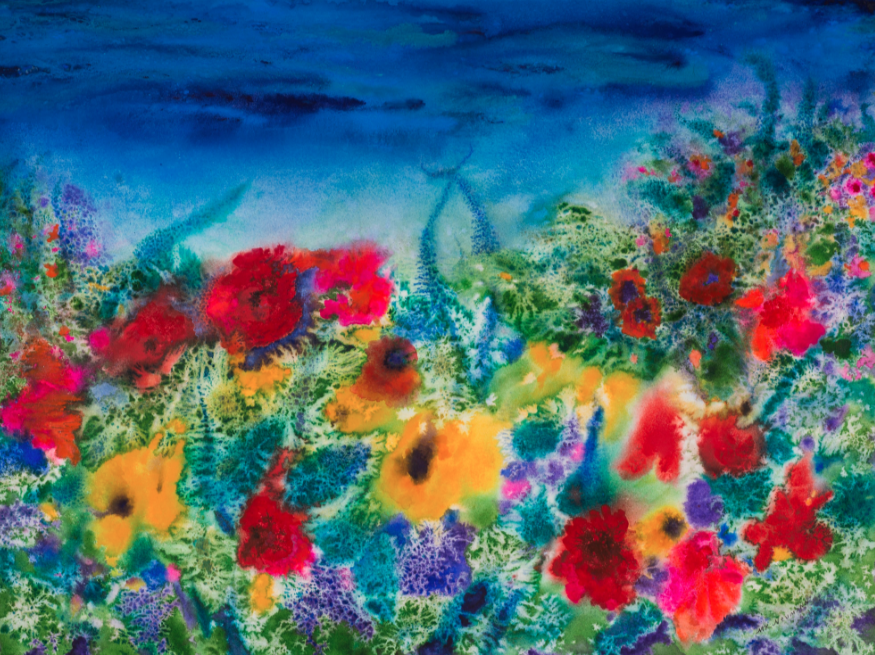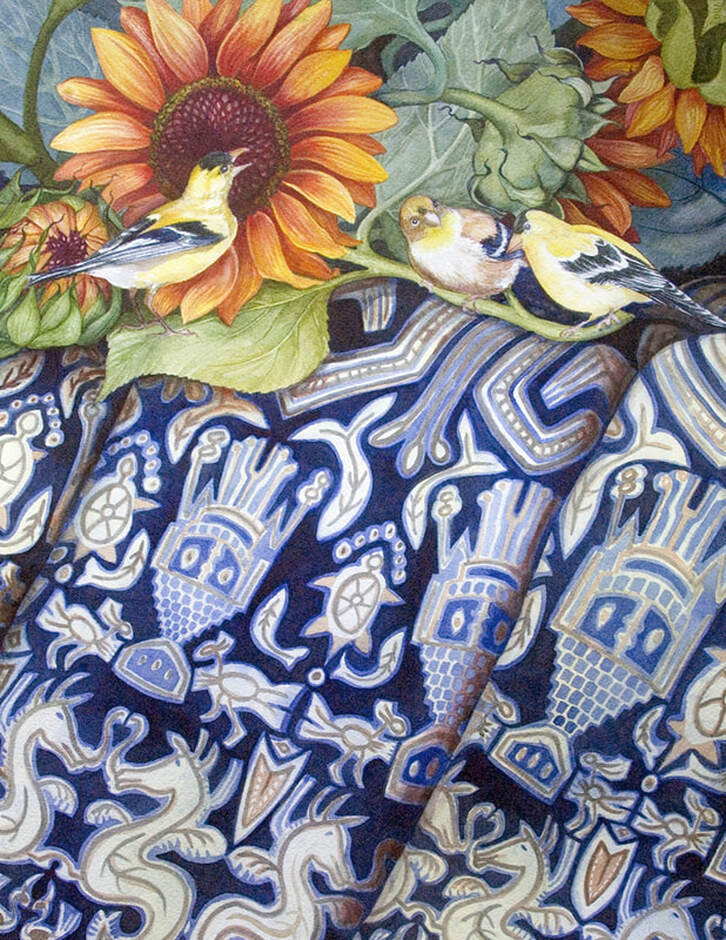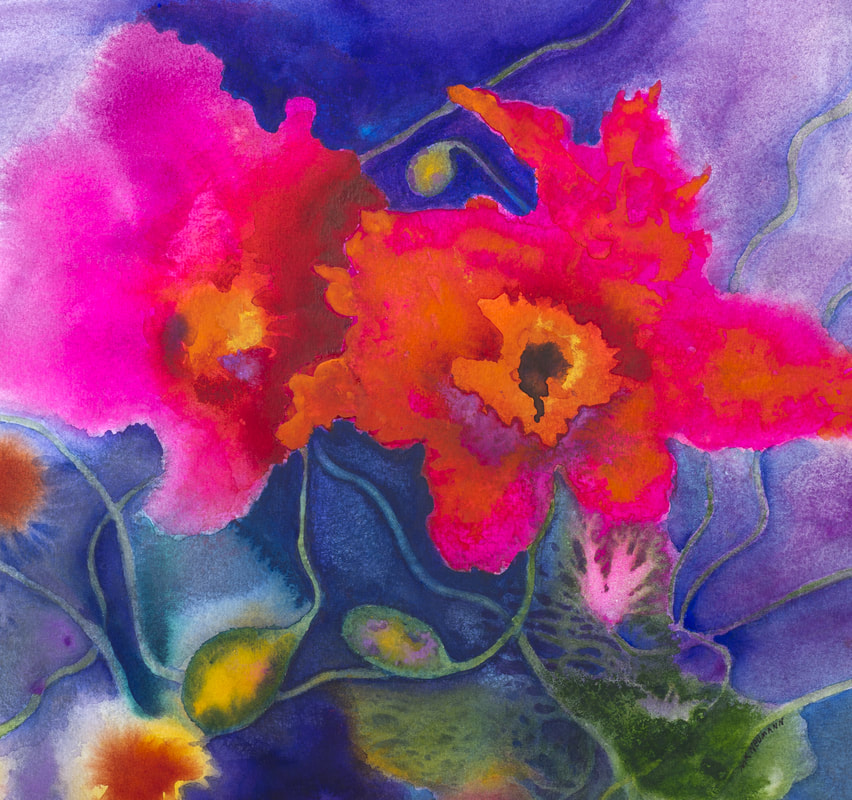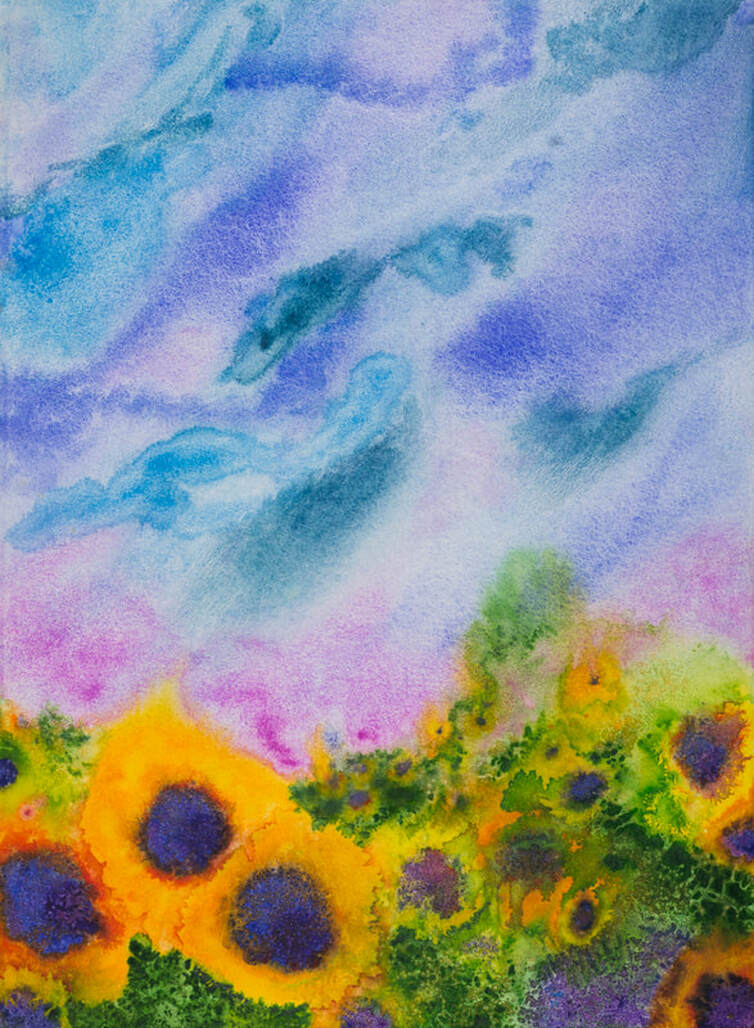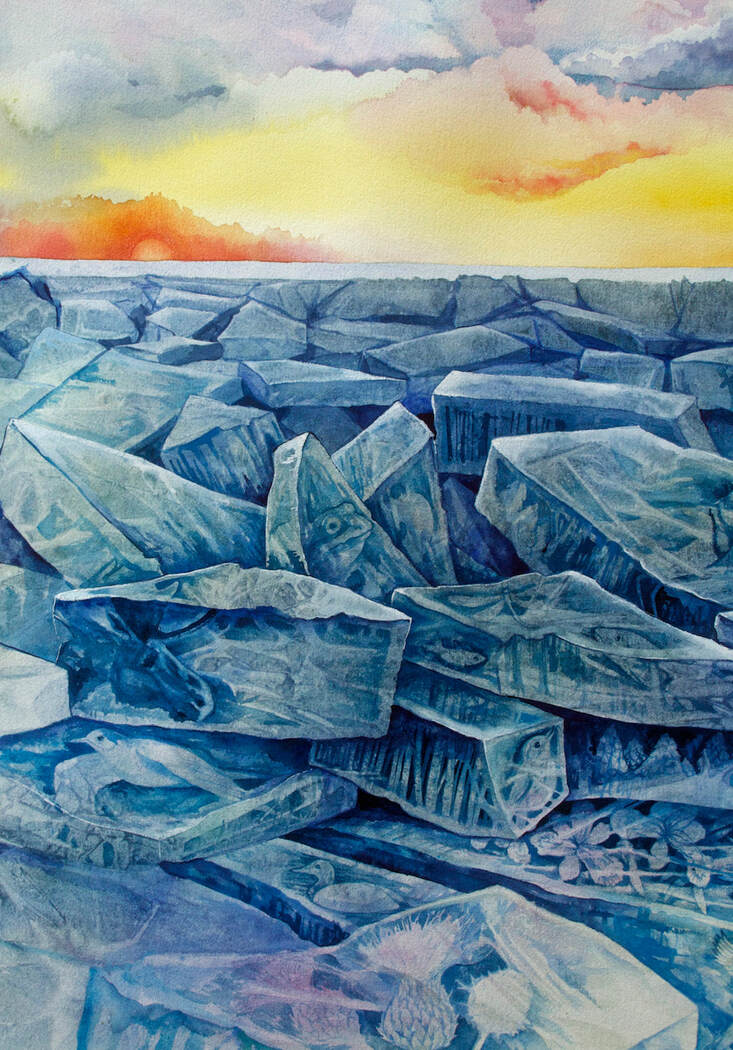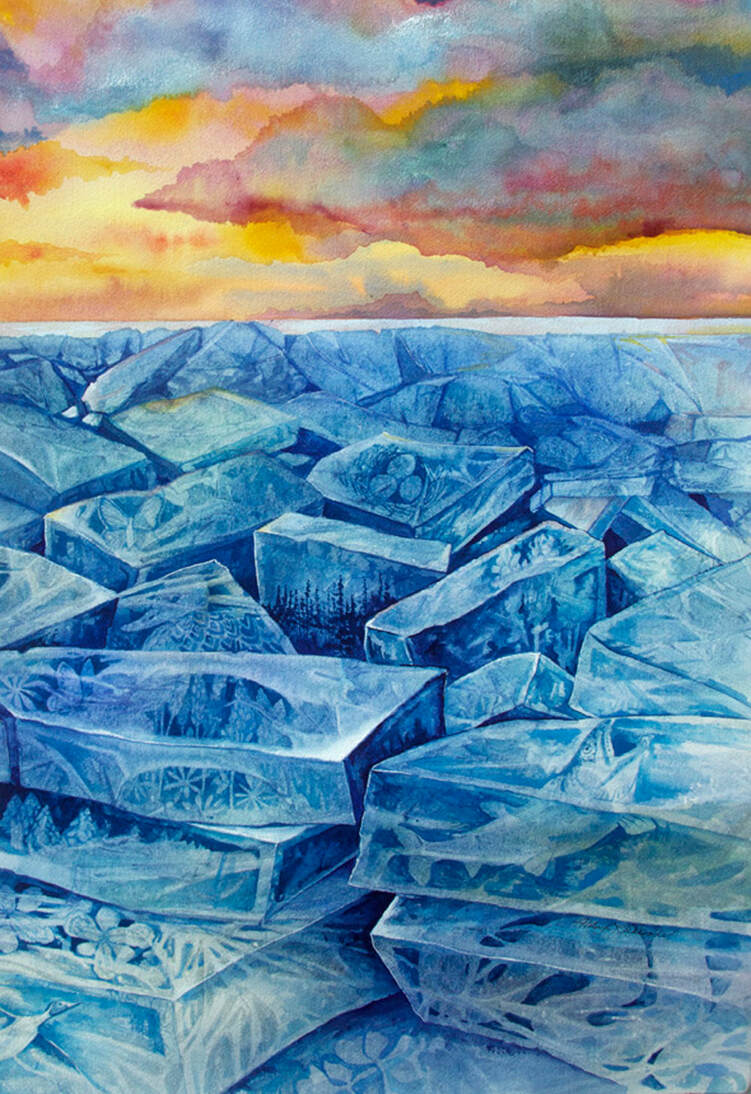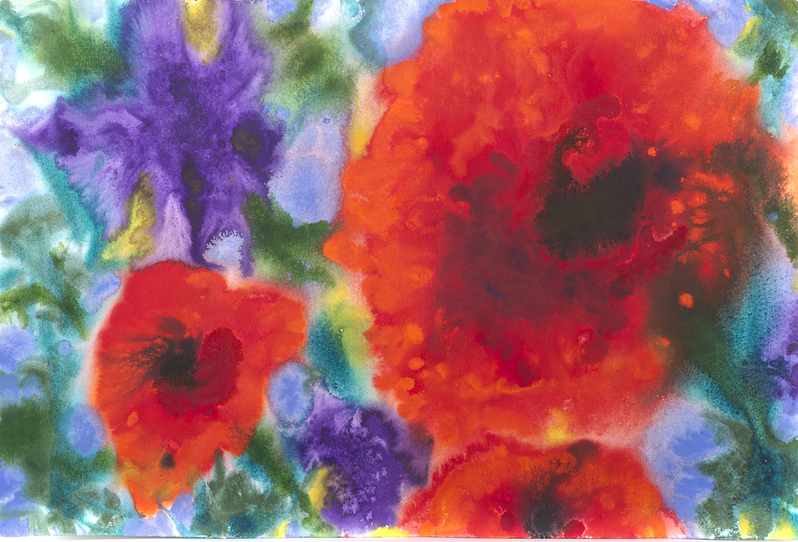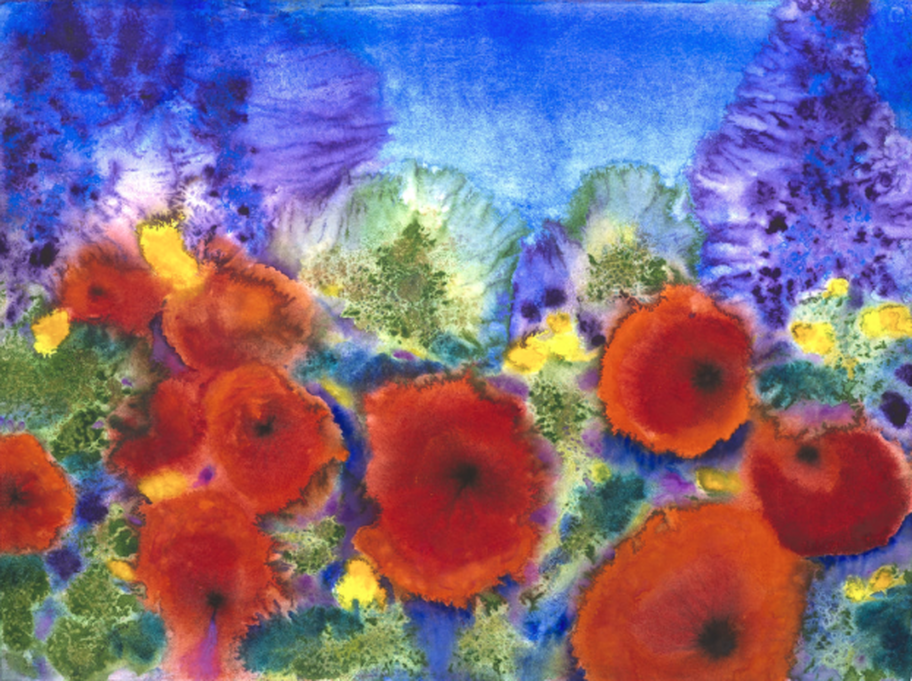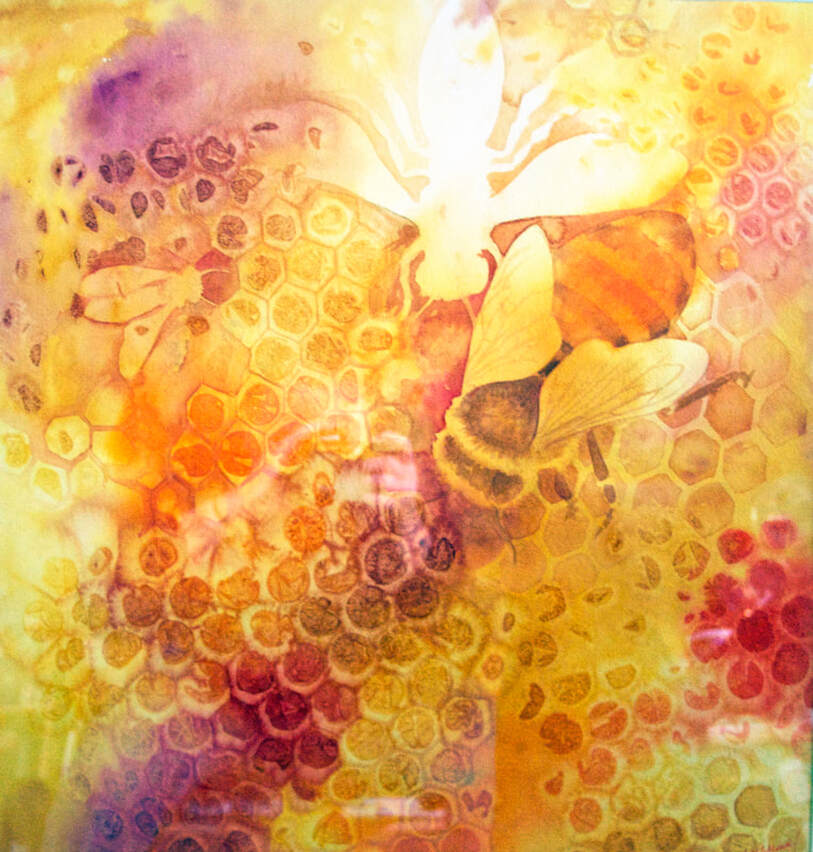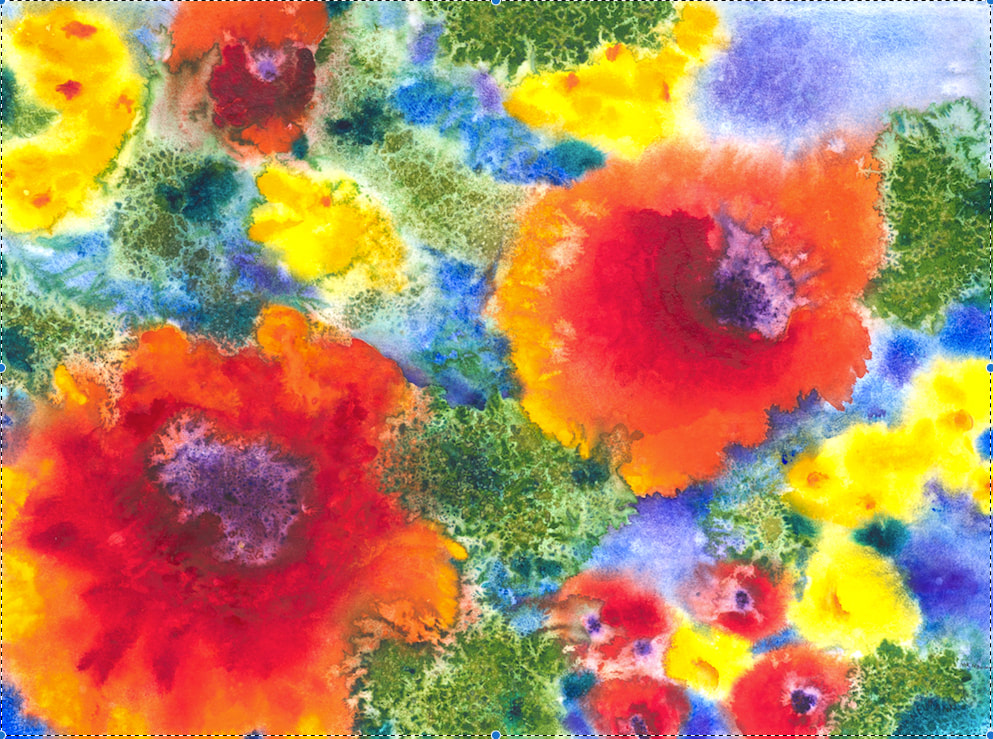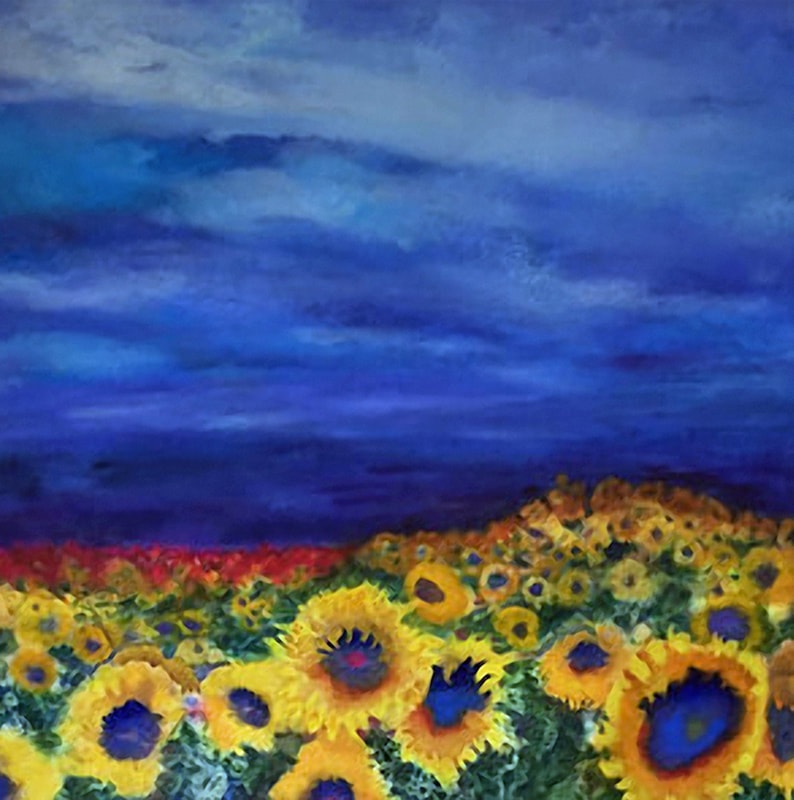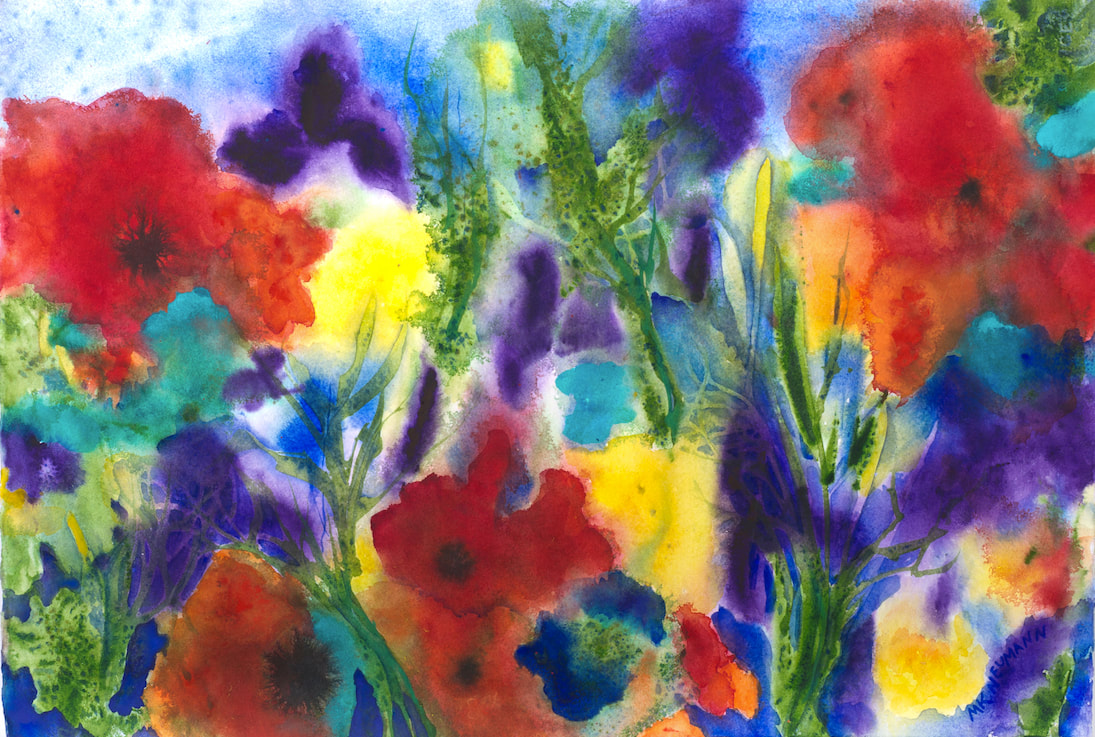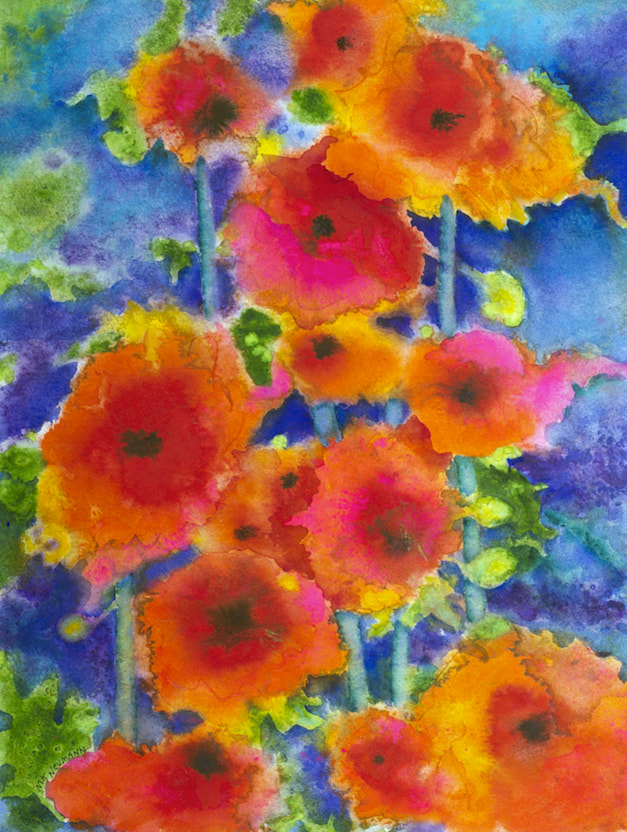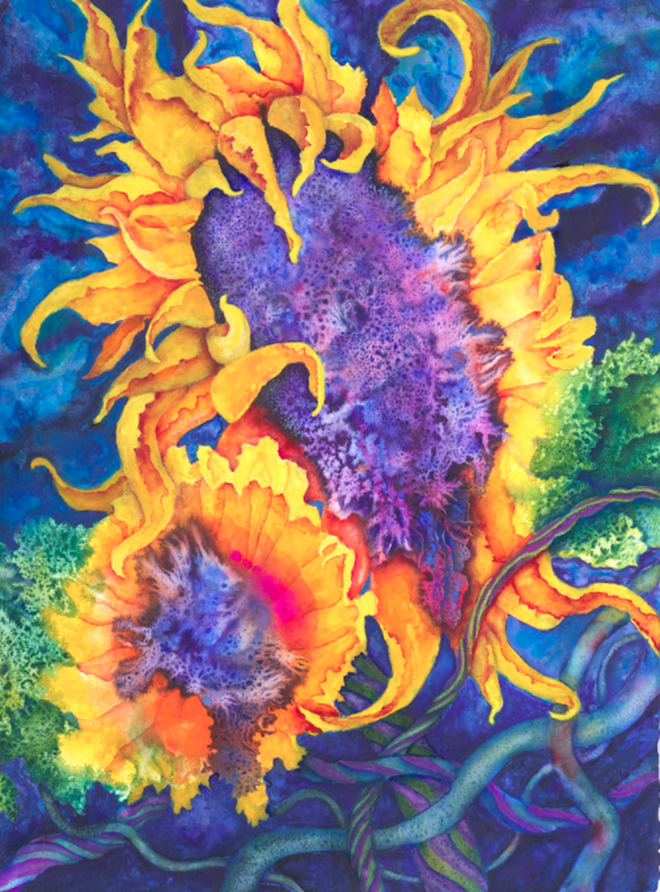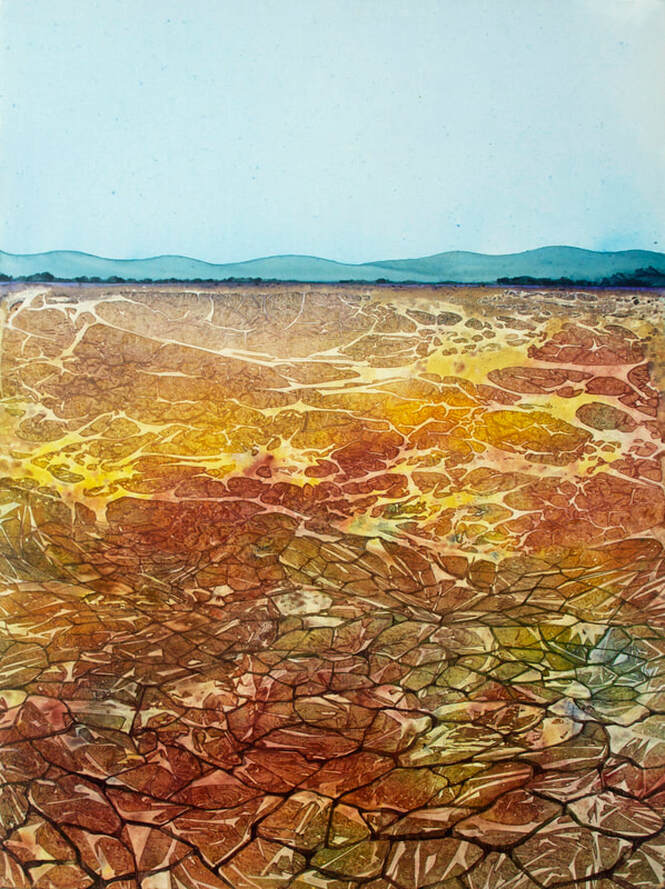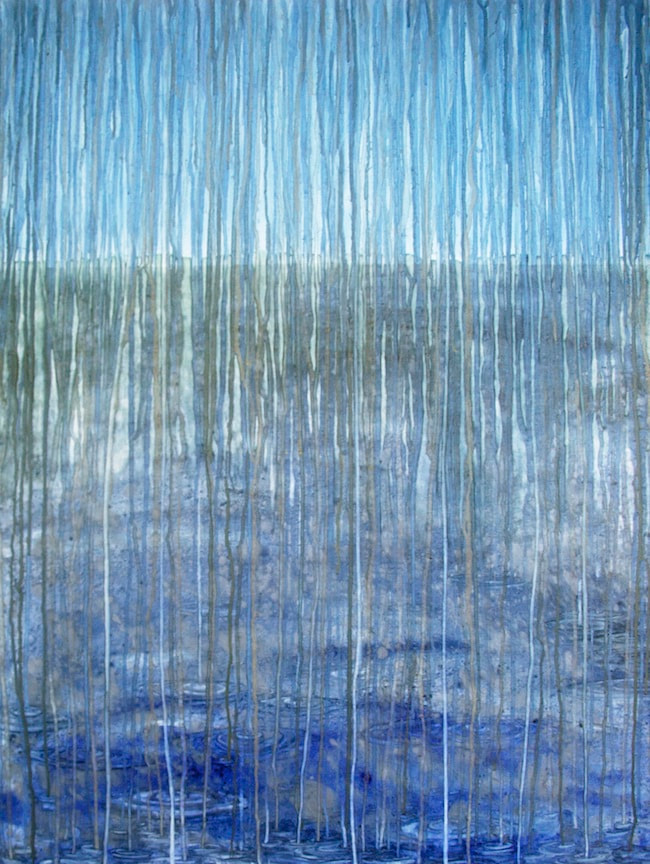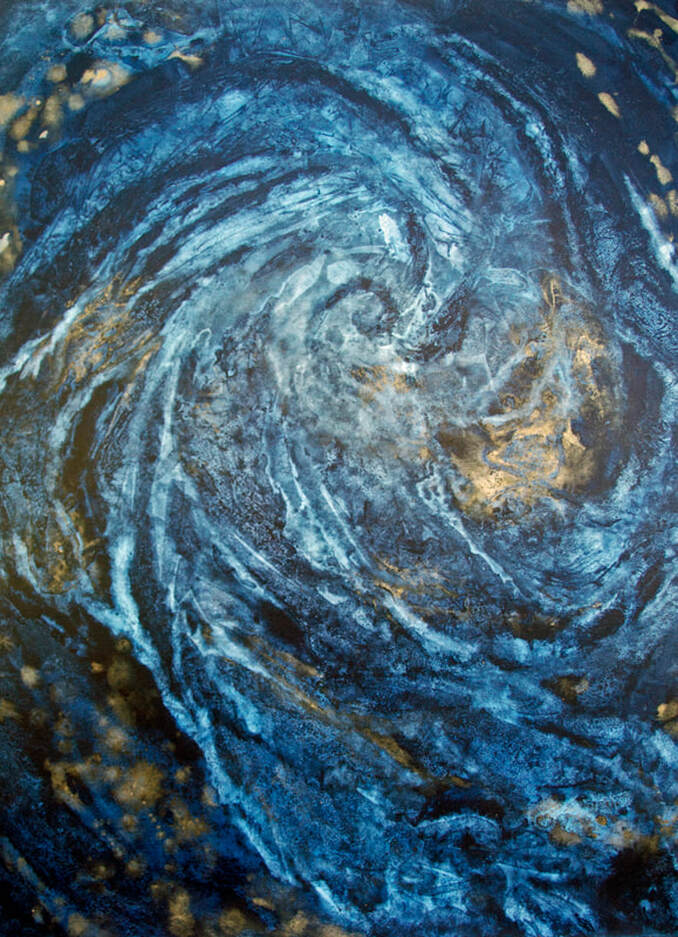THE FLOWERS ARE BURNING
“The Flowers are Burning:
An Art and Climate Justice Exhibition”
A Collaborative Project
Initiated in 2015
by Helen Klebesadel and Mary Kay Neumann
"The Flowers are Burning: An Art and Climate Justice Exhibition" seeks to evoke both a sense of alarm at our urgent environmental concerns and to hold up the vision of the possibility of rising from the ashes of a restorative prairie burn.
Artists Mary Kay Neumann and Helen Klebesadedal initiated this collaborative project in 2015. They embrace the potential of the flower as metaphor. Their watercolor paintings explore the poetic, symbolic and political representations that flowers offer in exploring both human nature and the natural world. Recognizing and celebrating the cultural association of flowers with the feminine, they pointedly render their paintings with strong color palettes, rich implied emotional content and complex compositions. Their large expressive flower paintings create environments of saturated color and texture that belies the fragility of flowers.
They consciously shift the historical stereotype of the female "flower painter" from something to be avoided by the serious woman artist to embracing flowers as creative and critical metaphors that are an inspiration for breaking through the paralysis of overwhelming despair and coming together with shared purpose.
Themes that move Klebesadel revolve around concerns for the negative effect of climate change on birds, bees and butterflies we take for granted, and by extension, what it means for humans. At the same time she holds out the possibility of abundant rejuvenation that prairie fires bring when nature is in balance with human activity..
Neumann's sunflower fields have looming fires that evoke the ominous droughts in California. Paintings of tidepools in peril speak to the ocean crises of warming seas and acidification, as well as the devastating Sea Star Wasting Disease, where starfish are literally melting away.
Haunted by the phenomenon of destructive climate change and injustice, the artists use their art to counter the denial and despair in favor of encouraging actions that could make a difference.
The distressing reality of our climate emergency often evokes the urge to look AWAY. We sought a different avenue to present these issues, and created beauty to help make it easier for our audience to look TOWARDS the art. We have painted images of the natural world that we love that are endangered by climate change, and ask our audience to notice what they love, and consider how they could become involved.
Both artists create large-scale watercolor paintings with rich color saturation. This exhibition highlights both individual artworks with shared themes and, for the first time, paintings that are co-painted. Helen and Mary Kay collaboratively painted several works through back and forth exchange. An amazing synergy emerged from their shared feminist values allowing effective cooperation and creative collaboration. These collaborations were unique from anything either artist could have created individually. Working together modeled a way forward for the larger world as we collectively approach making real, productive changes for our shared future.
Artists Mary Kay Neumann and Helen Klebesadedal initiated this collaborative project in 2015. They embrace the potential of the flower as metaphor. Their watercolor paintings explore the poetic, symbolic and political representations that flowers offer in exploring both human nature and the natural world. Recognizing and celebrating the cultural association of flowers with the feminine, they pointedly render their paintings with strong color palettes, rich implied emotional content and complex compositions. Their large expressive flower paintings create environments of saturated color and texture that belies the fragility of flowers.
They consciously shift the historical stereotype of the female "flower painter" from something to be avoided by the serious woman artist to embracing flowers as creative and critical metaphors that are an inspiration for breaking through the paralysis of overwhelming despair and coming together with shared purpose.
Themes that move Klebesadel revolve around concerns for the negative effect of climate change on birds, bees and butterflies we take for granted, and by extension, what it means for humans. At the same time she holds out the possibility of abundant rejuvenation that prairie fires bring when nature is in balance with human activity..
Neumann's sunflower fields have looming fires that evoke the ominous droughts in California. Paintings of tidepools in peril speak to the ocean crises of warming seas and acidification, as well as the devastating Sea Star Wasting Disease, where starfish are literally melting away.
Haunted by the phenomenon of destructive climate change and injustice, the artists use their art to counter the denial and despair in favor of encouraging actions that could make a difference.
The distressing reality of our climate emergency often evokes the urge to look AWAY. We sought a different avenue to present these issues, and created beauty to help make it easier for our audience to look TOWARDS the art. We have painted images of the natural world that we love that are endangered by climate change, and ask our audience to notice what they love, and consider how they could become involved.
Both artists create large-scale watercolor paintings with rich color saturation. This exhibition highlights both individual artworks with shared themes and, for the first time, paintings that are co-painted. Helen and Mary Kay collaboratively painted several works through back and forth exchange. An amazing synergy emerged from their shared feminist values allowing effective cooperation and creative collaboration. These collaborations were unique from anything either artist could have created individually. Working together modeled a way forward for the larger world as we collectively approach making real, productive changes for our shared future.
"Burned By The Fire We Make: Flowers are Burning Series"
Collaborative Watercolor by Mary Kay Neumann and Helen Klebesadel 22x30
“And when Man gained dominion
Over land and the oceans
He began to harm the planet
With his asphalt and his toxins
And to lay the forest bare
And to poison even the air
And he killed every beast
And taught the seas how to bleed
Burned by the fire we make,
What a shame.
Then the winds gave in
And the rain knew no season
And the sun came to beat
On a land of sand and diseases
And when God looked down
On the earth and saw it was broken
Then the tears of God fell down
Through a hole in the ozone
Burned by the fire we make
What a shame.
This is the nature of the human race
To kill off anything that gets in our way
Poor Mother Earth we disfigured her face
Man is the maker of his own disgrace
Burned by the fire we make
What a shame.”
– Lyrics by Adrian Belew, “Burned by the Fire We Make” Used by permission of Adrian Belew
“And when Man gained dominion
Over land and the oceans
He began to harm the planet
With his asphalt and his toxins
And to lay the forest bare
And to poison even the air
And he killed every beast
And taught the seas how to bleed
Burned by the fire we make,
What a shame.
Then the winds gave in
And the rain knew no season
And the sun came to beat
On a land of sand and diseases
And when God looked down
On the earth and saw it was broken
Then the tears of God fell down
Through a hole in the ozone
Burned by the fire we make
What a shame.
This is the nature of the human race
To kill off anything that gets in our way
Poor Mother Earth we disfigured her face
Man is the maker of his own disgrace
Burned by the fire we make
What a shame.”
– Lyrics by Adrian Belew, “Burned by the Fire We Make” Used by permission of Adrian Belew
"Silent Spring: Flowers are Burning Series"
Collaborative Watercolor by Mary Kay Neumann and Helen Klebesadel 22x30
|
"Those who contemplate the beauty of the earth find reserves of strength that will endure as long as life lasts. There is something infinitely healing in the repeated refrains of nature--the assurance that dawn comes after night, and spring after winter"
-Rachel Carson, Silent Spring |
"Paradise Lost: Flowers are Burning Series”
Collaborative Watercolor by Mary Kay Neumann and Helen Klebesadel 22x30
|
What do you miss that you used to see that is no longer in abundance; the whippoorwill, the woodcock, the monarch, the sturgeon? Then ask yourself: '
What am I willing to do to make a difference? How can I protect what is still there and keep what I love from disappearing forever? |
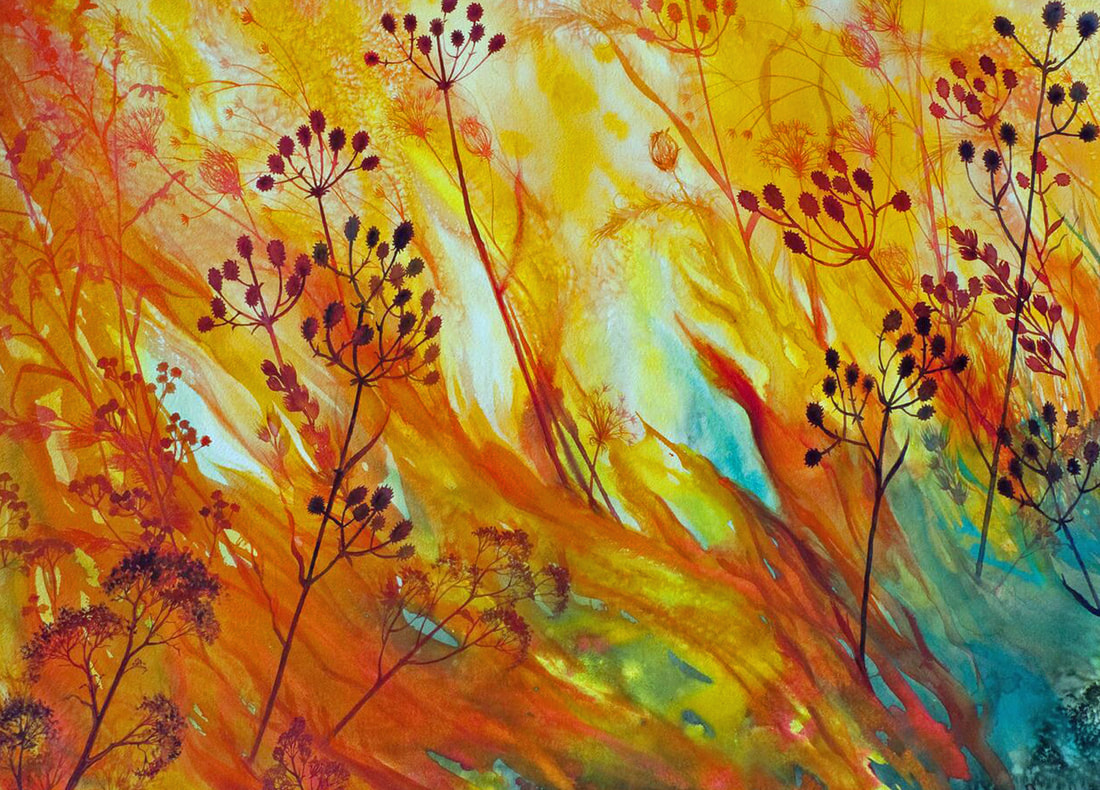
“Prairie Fire I: Flowers are Burning Series"
Helen Klebesadel, Watercolor 30x40
Fire rejuvenates prairies that are one of our most endangered eco systems. Prairie fires are a part of healthy prairie eco systems, slowing down the invasion of trees from the edges of the prairie and from wind-blown seeds, and by helping to speed up decomposition to return nutrients to the soil. This increases available nutrients through indirect stimulation of microbial activity in the soil and releasing nutrients from the ash. Fire suppresses many weeds and non-native invasives and kills many woody invasive plants, which, if left unchecked can quickly overtake a prairie. Fire keeps prairies in balance.
Fire rejuvenates prairies that are one of our most endangered eco systems. Prairie fires are a part of healthy prairie eco systems, slowing down the invasion of trees from the edges of the prairie and from wind-blown seeds, and by helping to speed up decomposition to return nutrients to the soil. This increases available nutrients through indirect stimulation of microbial activity in the soil and releasing nutrients from the ash. Fire suppresses many weeds and non-native invasives and kills many woody invasive plants, which, if left unchecked can quickly overtake a prairie. Fire keeps prairies in balance.
“Desire is Hunger, The Fire We Breath: Flowers are Burning Series”
Mary Kay Neumann, Watercolor 30x22
"...I add my own love to the history of people who have loved beautiful things, and looked out for them when they were lost, and tried to preserve them and save them while passing them along literally from hand to hand, singing out brilliantly from the wreck of time to the next generation of lovers, and the next."
-Donna Tartt, The Goldfinch
"...I add my own love to the history of people who have loved beautiful things, and looked out for them when they were lost, and tried to preserve them and save them while passing them along literally from hand to hand, singing out brilliantly from the wreck of time to the next generation of lovers, and the next."
-Donna Tartt, The Goldfinch
“Where are the Bees I? Pollinator Series"
Helen Klebesadel, Watercolor 30x22
Since 2006, beekeepers have been noticing their honeybee populations have been dying off at increasingly rapid rates. In 2015 American beekeepers reported losing 42 percent of their colonies. They are likely threatened by a combination of industrial agriculture practices, pests, insecticides, climate change and lack of nutrition due to habitat reduction. In addition to ongoing research into bee decline, efforts to improve habitats, and increased collaboration between crop growers and beekeepers to define bests practices, efforts are underway to teach and train amateur beekeepers in urban areas.
Since 2006, beekeepers have been noticing their honeybee populations have been dying off at increasingly rapid rates. In 2015 American beekeepers reported losing 42 percent of their colonies. They are likely threatened by a combination of industrial agriculture practices, pests, insecticides, climate change and lack of nutrition due to habitat reduction. In addition to ongoing research into bee decline, efforts to improve habitats, and increased collaboration between crop growers and beekeepers to define bests practices, efforts are underway to teach and train amateur beekeepers in urban areas.
"Whispers in the Dark: Flowers are Burning Series "
Mary Kay Neumann, Watercolor 22x30
"My intention...is to catalyze a next step, big or small, into the more beautiful world our hearts know is possible".
-Charles Eisenstein, The More Beautiful World Our Hearts Know is Possible
"My intention...is to catalyze a next step, big or small, into the more beautiful world our hearts know is possible".
-Charles Eisenstein, The More Beautiful World Our Hearts Know is Possible
"California Burning: Flowers Are Burning Series"
Mary Kay Neumann, Watercolor, 22zx30
“California is burning. The state is in the midst of one of the worst droughts in its history and has seen 1,000 more wildfires in 2015 than last year. In 2013 the largest wildfire ever in the Sierra Nevada, the Rim Fire, took two months to fully contain and seared more than 250,000 acres. Scientists warn that Californians should prepare for a future of more Rim Fires, fueled by climate change, drought, and forest mismanagement.”
-From” California Burning” website www.californiaburning.org
“California is burning. The state is in the midst of one of the worst droughts in its history and has seen 1,000 more wildfires in 2015 than last year. In 2013 the largest wildfire ever in the Sierra Nevada, the Rim Fire, took two months to fully contain and seared more than 250,000 acres. Scientists warn that Californians should prepare for a future of more Rim Fires, fueled by climate change, drought, and forest mismanagement.”
-From” California Burning” website www.californiaburning.org
"Prairie Fire II: Flowers are Burning Series"
Helen Klebesadel, Watercolor 30x40
"In the end we will conserve only what we love; we will love only what we understand; we will understand only what we have been taught".
-Baba Dioum
Prairies once covered over 40 percent of the United States. Now only about 1 percent of the North American prairie still exists. Prairies build soil, capture carbon, trap sediment, grow livestock and support pollinators. They provide us with flowers to enjoy, birds and butterflies to watch and wildlife. However, it becomes a personal relationship when we walk in prairies near us, learning about the nesting birds, the unique and threatened prairie plants and insects, and the small creatures that make their homes in prairies. Knowledge gained through experience allows us to love the prairie and that will make us want to conserve and preserve what we have left. Walk in a prairie.
"In the end we will conserve only what we love; we will love only what we understand; we will understand only what we have been taught".
-Baba Dioum
Prairies once covered over 40 percent of the United States. Now only about 1 percent of the North American prairie still exists. Prairies build soil, capture carbon, trap sediment, grow livestock and support pollinators. They provide us with flowers to enjoy, birds and butterflies to watch and wildlife. However, it becomes a personal relationship when we walk in prairies near us, learning about the nesting birds, the unique and threatened prairie plants and insects, and the small creatures that make their homes in prairies. Knowledge gained through experience allows us to love the prairie and that will make us want to conserve and preserve what we have left. Walk in a prairie.
"Flown This Acid World: Melting Sea Star Series"
Mary Kay Neumann, Watercolor, 12x6
"The frog does not drink up the pond in which he lives.”
-Native American Proverb
This painting depicts a tidepool with only fragments of sea stars after they have melted. After two years of speculation about the causes of Sea Star Wasting Disease, a study was just published on February 15, 2016. Scientists have confirmed that warm temperatures played a part in one of the ocean’s most devastating die-offs known to humans.
"The frog does not drink up the pond in which he lives.”
-Native American Proverb
This painting depicts a tidepool with only fragments of sea stars after they have melted. After two years of speculation about the causes of Sea Star Wasting Disease, a study was just published on February 15, 2016. Scientists have confirmed that warm temperatures played a part in one of the ocean’s most devastating die-offs known to humans.
"Where Are The Bees II? Pollinator Series"
Helen Klebesadel. Watercolor, 30x22
We are not certain why butterflies, wild bees and honeybee deaths are rising but habitat loss and pesticides are at least part of the problem. Both honeybees and monarchs have been in steep decline over the last decade or more, with the monarch population dropping as much as 90 percent. In Europe a tenth of wild bee species are facing extinction. Research continues and the US has committed to adding or improving wildflower habitat on seven million acres of public land by 2020. It is a small start, but it is a beginning.
We are not certain why butterflies, wild bees and honeybee deaths are rising but habitat loss and pesticides are at least part of the problem. Both honeybees and monarchs have been in steep decline over the last decade or more, with the monarch population dropping as much as 90 percent. In Europe a tenth of wild bee species are facing extinction. Research continues and the US has committed to adding or improving wildflower habitat on seven million acres of public land by 2020. It is a small start, but it is a beginning.
“With the Birds I Share This Lonely View: Melting Sea Star Series”
Mary Kay Neumann, Watercolor 30x22
When I traveled to the West Coast in April 2015, I visited the tidepools, hoping to find a health starfish. While looking out over the mussel bead that should have been covered with piles of intermingling starfish, I was joined by a woman who lived nearby. She mentioned how beautiful it was to see the tidepools. I asked her "Do you notice anything missing?" She stopped for a few moments and looker around and said "Where are the starfish?"
Sea stars (commonly called starfish) are dying off by the millions all along the Pacific Coast from Sea Star Wasting Disease , and we don't know why. They get sick and lose their arms and die, literally melting into a pile of goo. Sea stars are a keystone species in the tidepools and what happens to them affects all other forms of tidepool life. This entire ecosystem is in danger from warming oceans, marine diseases and water acidification.
"Knowing is the key to caring, and with caring there is hope that people will be motivated to take positive actions".
-Dr. Sylvia Earle, marine biologist
When I traveled to the West Coast in April 2015, I visited the tidepools, hoping to find a health starfish. While looking out over the mussel bead that should have been covered with piles of intermingling starfish, I was joined by a woman who lived nearby. She mentioned how beautiful it was to see the tidepools. I asked her "Do you notice anything missing?" She stopped for a few moments and looker around and said "Where are the starfish?"
Sea stars (commonly called starfish) are dying off by the millions all along the Pacific Coast from Sea Star Wasting Disease , and we don't know why. They get sick and lose their arms and die, literally melting into a pile of goo. Sea stars are a keystone species in the tidepools and what happens to them affects all other forms of tidepool life. This entire ecosystem is in danger from warming oceans, marine diseases and water acidification.
"Knowing is the key to caring, and with caring there is hope that people will be motivated to take positive actions".
-Dr. Sylvia Earle, marine biologist
“The Last Waltz: Melting Sea Star Series”
Mary Kay Neumann, Watercolor 30x40
"All things are one thing and that one thing is all things...plankton, a shimmering phosphorescence on the sea, the spinning planets and expanding universe, all bound together by the elastic string of time. It is advisable to look from the tidepool to the stars and back to the tidepool again."
-John Steinbeck, Sea of Cortez
Millions of sea stars have died on the Pacific Coast from Sea Star Wasting Disease, what ocean scientists call the single largest, most geographically widespread marine disease ever recorded. Tidepools and the creatures that inhabit them are in danger from warming oceans, pollution, marine disease and water acidification. Sea Star Wasting Disease struck in the summer of 2014. When the sea stars get sick, they develop lesions on their outer bodies, dissolving tissue from the outside to the inside. Their arms then detach from their bodies and the animal dies, literally melting into piles of disconnected limbs. Sea stars are a keystone species to the marine ecosystem and when they die off, the balance to the entire chain of life in the ocean is at risk.
This painting depicts the sea stars in the "melting" phase of Sea Star Wasting Disease, where they are barely recognizable shapes, only hinting at the forms they once were. The process of disintegrations continues as the disease dissolves them. Notice the hint of hopeful juveniles, providing hope that they can survive this disease outbreak.
All is not yet lost. While it is estimated that 95% of adult sea stars have died along the West Coast, hope is still alive. Juveniles have been found that have survived this devastating disease, and there is optimism that the sea star population may recover. However, we must tak real action to save them and the rest of the marine eco system.
"All things are one thing and that one thing is all things...plankton, a shimmering phosphorescence on the sea, the spinning planets and expanding universe, all bound together by the elastic string of time. It is advisable to look from the tidepool to the stars and back to the tidepool again."
-John Steinbeck, Sea of Cortez
Millions of sea stars have died on the Pacific Coast from Sea Star Wasting Disease, what ocean scientists call the single largest, most geographically widespread marine disease ever recorded. Tidepools and the creatures that inhabit them are in danger from warming oceans, pollution, marine disease and water acidification. Sea Star Wasting Disease struck in the summer of 2014. When the sea stars get sick, they develop lesions on their outer bodies, dissolving tissue from the outside to the inside. Their arms then detach from their bodies and the animal dies, literally melting into piles of disconnected limbs. Sea stars are a keystone species to the marine ecosystem and when they die off, the balance to the entire chain of life in the ocean is at risk.
This painting depicts the sea stars in the "melting" phase of Sea Star Wasting Disease, where they are barely recognizable shapes, only hinting at the forms they once were. The process of disintegrations continues as the disease dissolves them. Notice the hint of hopeful juveniles, providing hope that they can survive this disease outbreak.
All is not yet lost. While it is estimated that 95% of adult sea stars have died along the West Coast, hope is still alive. Juveniles have been found that have survived this devastating disease, and there is optimism that the sea star population may recover. However, we must tak real action to save them and the rest of the marine eco system.
“Prairie Fire III: Flowers are Burning Series"
Helen Klebesadel, watercolor, 30x40
Wild Geese
"You do not have to be good.
You do not have to walk on your knees
For a hundred miles through the desert, repenting.
You only have to let the soft animal of your body
love what it loves.
Tell me about your despair, yours, and I will tell you mine.
Meanwhile the world goes on.
Meanwhile the sun and the clear pebbles of the rain
are moving across the landscapes,
over the prairies and the deep trees,
the mountains and the rivers.
Meanwhile the wild geese, high in the clean blue air,
are heading home again.
Whoever you are, no matter how lonely,
the world offers itself to your imagination,
calls to you like the wild geese, harsh and exciting --
over and over announcing your place
in the family of things."
-Mary Oliver
Wild Geese
"You do not have to be good.
You do not have to walk on your knees
For a hundred miles through the desert, repenting.
You only have to let the soft animal of your body
love what it loves.
Tell me about your despair, yours, and I will tell you mine.
Meanwhile the world goes on.
Meanwhile the sun and the clear pebbles of the rain
are moving across the landscapes,
over the prairies and the deep trees,
the mountains and the rivers.
Meanwhile the wild geese, high in the clean blue air,
are heading home again.
Whoever you are, no matter how lonely,
the world offers itself to your imagination,
calls to you like the wild geese, harsh and exciting --
over and over announcing your place
in the family of things."
-Mary Oliver
"A Caution to the Birds: Tidepools in Peril Series"
Mary Kay Neumann, Watercolor, 15x20
“The Time will soon be here when my grandchild will long for the cry of a loon, the flash of a salmon, the whisper of spruce needles, or the screech of an eagle. But he will not make friends with any of these creatures, and when his heart aches with longing, he will curse me.
“Have I done all to keep the air fresh? Have I cared enough about the water? Have I left the eagle to soar in freedom? Have I done everything I could to earn my grandchild’s fondness?”
-Chief Dan George, Tsleil-Waututh Nation
“The Time will soon be here when my grandchild will long for the cry of a loon, the flash of a salmon, the whisper of spruce needles, or the screech of an eagle. But he will not make friends with any of these creatures, and when his heart aches with longing, he will curse me.
“Have I done all to keep the air fresh? Have I cared enough about the water? Have I left the eagle to soar in freedom? Have I done everything I could to earn my grandchild’s fondness?”
-Chief Dan George, Tsleil-Waututh Nation
"Where Are The Bees? IV: Pollinator Series"
Helen Klebesadel, Watercolor, 30x22
Scientists point to several causes behind the problem of colony collapse, including global warming, habitat loss, parasites and a class of bee-killing insecticides known as neonicotinoids (or neonics). While neonics are harmless to humans (which is why we started using them) they are 6000 times more toxic to bees than DDT. Alarmed by the role these chemicals are playing in bee colony collapse disorder, the European Union has banned several of them; the U.S. Fish and Wildlife Service has committed to phasing them out on the public lands they manage. The Environmental Protection Agency (EPA) announced in early 2016 for the first time recognized the risk of a neonicotinoid pesticide. Here is what we can do:
Scientists point to several causes behind the problem of colony collapse, including global warming, habitat loss, parasites and a class of bee-killing insecticides known as neonicotinoids (or neonics). While neonics are harmless to humans (which is why we started using them) they are 6000 times more toxic to bees than DDT. Alarmed by the role these chemicals are playing in bee colony collapse disorder, the European Union has banned several of them; the U.S. Fish and Wildlife Service has committed to phasing them out on the public lands they manage. The Environmental Protection Agency (EPA) announced in early 2016 for the first time recognized the risk of a neonicotinoid pesticide. Here is what we can do:
- Ban the seven most dangerous pesticides.
- Protect pollinator health by preserving wild habitat.
- Restore ecological agriculture
"What a Little Moonlight Can Do: Tidepools in Peril Series"
Mary Kay Neumann, Watercolor, 12x16
“The Goddess is not separate from the world—she IS the world, and all things in it: moon, sun, earth, star, stone, seed, flowing river, wind, wave, leaf and branch, bud and blossom, fang and claw, woman and man.”
-Starhawk
“The Goddess is not separate from the world—she IS the world, and all things in it: moon, sun, earth, star, stone, seed, flowing river, wind, wave, leaf and branch, bud and blossom, fang and claw, woman and man.”
-Starhawk
"Winter's Warning: Disappearing Cold Series"
Helen Klebesadel, Watercolor, 60x40
This painting uses the Lake Superior ice break up coupled with a dramatic orange sunset to represent the consequences of global warming for our plant and animal species in our northern ecosystems as we move toward an end of winter as we have known it. Imbedded in the ice are images of flora and fauna that will move north with the cold to survive. Look closely and you can find images of the cold weather dependent trees, flower, insects, fish, birds, and animals that Wisconsin will lose as the climate warms. The painting toured in the exhibition "Paradise Lost? Climate Change in the North Woods" in 2008-2009, resulting from an artist/scientist collaborative effort to bring attention to the science of climate change through the arts.
This painting uses the Lake Superior ice break up coupled with a dramatic orange sunset to represent the consequences of global warming for our plant and animal species in our northern ecosystems as we move toward an end of winter as we have known it. Imbedded in the ice are images of flora and fauna that will move north with the cold to survive. Look closely and you can find images of the cold weather dependent trees, flower, insects, fish, birds, and animals that Wisconsin will lose as the climate warms. The painting toured in the exhibition "Paradise Lost? Climate Change in the North Woods" in 2008-2009, resulting from an artist/scientist collaborative effort to bring attention to the science of climate change through the arts.
"Walk on the Wild Side: Tidepools in Peril Series"
Mary Kay Neumann, Watercolor 22x30
“The idea of wilderness needs no defense, it only needs defenders”
-Edward Abbey
“The idea of wilderness needs no defense, it only needs defenders”
-Edward Abbey
"Love Is A Banquet on Which We Feed: Flowers are Burning Series"
Mary Kay Neumann, Watercolor, 14x20
“When we learn to think with the mind descended into the heart—integrating cognition and emotion with other faculties like sensation, intuition and bodily knowledge—the result can be insight, wisdom and the courage to act on what we know. "
-Parker Palmer, Healing the Heart of Democracy: The Courage to Create a Politics Worthy of the Human Spirit
“The Flowers Are Burning” was created as a vehicle to address losses in nature of the things we love. Our meaning of the word “love” is not romantic or sentimental. We are naming a power inside of us that springs forth from the deepest ways of knowing a human being can draw from, of our “mind descending into the heart.” May we all find that courage deep inside.
“When we learn to think with the mind descended into the heart—integrating cognition and emotion with other faculties like sensation, intuition and bodily knowledge—the result can be insight, wisdom and the courage to act on what we know. "
-Parker Palmer, Healing the Heart of Democracy: The Courage to Create a Politics Worthy of the Human Spirit
“The Flowers Are Burning” was created as a vehicle to address losses in nature of the things we love. Our meaning of the word “love” is not romantic or sentimental. We are naming a power inside of us that springs forth from the deepest ways of knowing a human being can draw from, of our “mind descending into the heart.” May we all find that courage deep inside.
"Thorn Birds: Flowers Are Burning Series"
Helen Klebesadel , Watercolor, 30x22
Like so many other bird species the Baltimore Oriole is in increasingly hostile territory they are threatened by deforestation and pesticide use on trees, as well as climate change. As the temperature across the U.S. has gotten warmer the Oriole, like 314 other North American bird species, is spending its winters farther north than they used to. Migratory birds are arriving earlier, sometimes before their traditional food sources are available. Research predicts that more than half of the birds in North America are now or soon will be threatened by climate change. Now every bird is a Canary in a mineshaft. Let us not let them go. Remember, those Canaries were used to determine if there was air enough for humans to survive.
Like so many other bird species the Baltimore Oriole is in increasingly hostile territory they are threatened by deforestation and pesticide use on trees, as well as climate change. As the temperature across the U.S. has gotten warmer the Oriole, like 314 other North American bird species, is spending its winters farther north than they used to. Migratory birds are arriving earlier, sometimes before their traditional food sources are available. Research predicts that more than half of the birds in North America are now or soon will be threatened by climate change. Now every bird is a Canary in a mineshaft. Let us not let them go. Remember, those Canaries were used to determine if there was air enough for humans to survive.
"Sending Out an S.O.S: Melting Sea Star Series"
Mary Kay Neumann, Watercolor, 30x20
“One day a man was walking along the beach when he noticed a boy picking something up and gently throwing it into the ocean.
Approaching the boy, he asked, ‘What are you doing?’
The youth replied, ‘I’m throwing the starfish back into the ocean. The surf is up and the tide is going out. If I don’t throw them back they’ll die.’
‘Son’, the man said ‘don’t you realize there are miles and miles of beach and hundreds and hundreds of starfish? You can’t make a difference.’
After listening politely, the boy bent down, picked up another starfish, and threw it back into the surf.
Then, smiling at the man, he said, ‘I made a difference for that one.’”
-Loren Eiseley
This painting shows the final stages of Sea Star Wasting Syndrome. The animals have succumbed to the illness and have melted into unrecognizable body parts floating in the tidepool.
“One day a man was walking along the beach when he noticed a boy picking something up and gently throwing it into the ocean.
Approaching the boy, he asked, ‘What are you doing?’
The youth replied, ‘I’m throwing the starfish back into the ocean. The surf is up and the tide is going out. If I don’t throw them back they’ll die.’
‘Son’, the man said ‘don’t you realize there are miles and miles of beach and hundreds and hundreds of starfish? You can’t make a difference.’
After listening politely, the boy bent down, picked up another starfish, and threw it back into the surf.
Then, smiling at the man, he said, ‘I made a difference for that one.’”
-Loren Eiseley
This painting shows the final stages of Sea Star Wasting Syndrome. The animals have succumbed to the illness and have melted into unrecognizable body parts floating in the tidepool.
"Lover of the Light: Flowers Are Burning Series"
Mary Kay Neumann, Watercolor, 22x30
"There is an ancient bond with the natural world surviving deep within us, which makes it not a luxury, not an optional extra, but a part of our essence...the natural home for our psyches where we can find not only joy, but peace. And to destroy it is to destroy a fundamental part of ourselves. Should we lose it, we would be less whole...less than we have evolved to be...we would find true peace impossible."
-Michael McCarthy , The Moth Snowstorm: Nature and Joy
"There is an ancient bond with the natural world surviving deep within us, which makes it not a luxury, not an optional extra, but a part of our essence...the natural home for our psyches where we can find not only joy, but peace. And to destroy it is to destroy a fundamental part of ourselves. Should we lose it, we would be less whole...less than we have evolved to be...we would find true peace impossible."
-Michael McCarthy , The Moth Snowstorm: Nature and Joy
"Finches and Sea Dragon: Flowers Are Burning Series"
Helen Klebesadel, Watercolor, 30x22
Human beings love finding repeating patterns in nature so we can learn from them. The spirals in the seeds of these sunflowers can be metaphors for intersecting and repeating patterns in nature. The Wisconsin Yellow Finch is often called a wild canary. Research predicts that more than half of the birds in North America are now or soon will be threatened by climate change. Their plight reflects patterns taking place all over the world. Warming weather coupled with habitat destruction increases that threat. We love bringing nature into all of our arts. The fabric in this painting contains a pattern inspired by seahorses and sea dragons found in the Earth’s oceans. They too are threatened by warming waters and acidification of global warming, but even more so by humans that capture them and use them in medicine, for jewelry and ornaments, or for consumption. Species on land and in the ocean require us to notice how our actions impact their ability to survive. It might help to remember that they are our canaries in the coalmine of the earth that we share.
Human beings love finding repeating patterns in nature so we can learn from them. The spirals in the seeds of these sunflowers can be metaphors for intersecting and repeating patterns in nature. The Wisconsin Yellow Finch is often called a wild canary. Research predicts that more than half of the birds in North America are now or soon will be threatened by climate change. Their plight reflects patterns taking place all over the world. Warming weather coupled with habitat destruction increases that threat. We love bringing nature into all of our arts. The fabric in this painting contains a pattern inspired by seahorses and sea dragons found in the Earth’s oceans. They too are threatened by warming waters and acidification of global warming, but even more so by humans that capture them and use them in medicine, for jewelry and ornaments, or for consumption. Species on land and in the ocean require us to notice how our actions impact their ability to survive. It might help to remember that they are our canaries in the coalmine of the earth that we share.
"Eyes Like Sparks: Tidepools in Peril Series"
, Mary Kay Neumann, Watercolor, 12x14
“When I use my strength in the service of my vision, it makes no difference whether or not I am afraid.”
-Audre Lorde
“When I use my strength in the service of my vision, it makes no difference whether or not I am afraid.”
-Audre Lorde
"What to Remember When Waking: Flowers are Burning Series"
Mary Kay Neumann, Watercolor, 30x22
“In that first hardly noticed moment in which you wake,
coming back to this life from the other
more secret, moveable and frighteningly honest world
where everything began,
there is a small opening into the new day
which closes the moment you begin your plans.
What you can plan is too small for you to live.
What you can live wholeheartedly will make plans enough
for the vitality hidden in your sleep.
To be human is to become visible
while carrying what is hidden as a gift to others.
To remember the other world in this world
is to live in your true inheritance.
You are not a troubled guest on this earth,
you are not an accident amidst other accidents
you were invited from another and greater night
than the one from which you have just emerged.
Now, looking through the slanting light of the morning window
toward the mountain presence of everything that can be
what urgency calls you to your one love?
What shape waits in the seed of you
to grow and spread its branches
against a future sky?
Is it waiting in the fertile sea?
In the trees beyond the house?
In the life you can imagine for yourself?
In the open and lovely white page on the writing desk?”
- David Whyte
“In that first hardly noticed moment in which you wake,
coming back to this life from the other
more secret, moveable and frighteningly honest world
where everything began,
there is a small opening into the new day
which closes the moment you begin your plans.
What you can plan is too small for you to live.
What you can live wholeheartedly will make plans enough
for the vitality hidden in your sleep.
To be human is to become visible
while carrying what is hidden as a gift to others.
To remember the other world in this world
is to live in your true inheritance.
You are not a troubled guest on this earth,
you are not an accident amidst other accidents
you were invited from another and greater night
than the one from which you have just emerged.
Now, looking through the slanting light of the morning window
toward the mountain presence of everything that can be
what urgency calls you to your one love?
What shape waits in the seed of you
to grow and spread its branches
against a future sky?
Is it waiting in the fertile sea?
In the trees beyond the house?
In the life you can imagine for yourself?
In the open and lovely white page on the writing desk?”
- David Whyte
"End of Cold I: Disappearing Cold Series"
Helen Klebesadel, watercolor, 22x22
This watercolor study for a larger work considers our place in the landscape and our relationship, as humans, to nature, including the species that are dependent on cold for their survival. Depicting the Lake Superior ice break up, imbedded with images of the cold weather dependent trees, flower, insects, fish, birds, and animals are used as a metaphor for what we will lose when the ice melts. Records kept at Aldo Leopold’s cabin near Baraboo show that migratory geese are returning a month sooner and plants are blooming over a week earlier as compared to what Leopold recorded there 70 years ago. Residents of the Duluth-Superior area say they are becoming accustomed to now seeing nesting cardinals and tomatoes turning red before the first killing frost of fall.
Immediate, significant reductions in carbon dioxide and other greenhouse gas emissions will help slow down the rate of climate change, reduce the magnitude of change in the future, and help improve our ability to adapt. We can and must begin greatly reducing our greenhouse gas emissions.
This watercolor study for a larger work considers our place in the landscape and our relationship, as humans, to nature, including the species that are dependent on cold for their survival. Depicting the Lake Superior ice break up, imbedded with images of the cold weather dependent trees, flower, insects, fish, birds, and animals are used as a metaphor for what we will lose when the ice melts. Records kept at Aldo Leopold’s cabin near Baraboo show that migratory geese are returning a month sooner and plants are blooming over a week earlier as compared to what Leopold recorded there 70 years ago. Residents of the Duluth-Superior area say they are becoming accustomed to now seeing nesting cardinals and tomatoes turning red before the first killing frost of fall.
Immediate, significant reductions in carbon dioxide and other greenhouse gas emissions will help slow down the rate of climate change, reduce the magnitude of change in the future, and help improve our ability to adapt. We can and must begin greatly reducing our greenhouse gas emissions.
"End of Cold II: Disappearing Cold Series"
Helen Klebesadel, Watercolor, 22x11
Mean temperatures in the upper Great Lakes region have gone up nearly four degrees over the last century. About two-thirds of that increase was recorded just within the last 30 years. Before the century ends, average summer temperatures are projected to increase by as much as eight to 18 degrees and average winter temperatures will rise six to 11 degrees.
“The first thing Wisconsin must do is to begin greatly reducing its own greenhouse gas emissions. Next, we must anticipate and prepare for the possibility of severe summer droughts, extreme heat waves, more frequent severe storms and strong tornadoes, heavy rains and snowfalls, ice storms, and record flooding.
We also need to be prepared for any disruption to power, water and food supplies that climatic events may cause. It has always been wise to make such emergency preparations, but the expected—and especially the unforeseen—consequences of a changing climate will make such preparations increasingly important in the years ahead.“
~Wisconsin Climate 2000, University of Wisconsin Sea Grant Institute
Mean temperatures in the upper Great Lakes region have gone up nearly four degrees over the last century. About two-thirds of that increase was recorded just within the last 30 years. Before the century ends, average summer temperatures are projected to increase by as much as eight to 18 degrees and average winter temperatures will rise six to 11 degrees.
“The first thing Wisconsin must do is to begin greatly reducing its own greenhouse gas emissions. Next, we must anticipate and prepare for the possibility of severe summer droughts, extreme heat waves, more frequent severe storms and strong tornadoes, heavy rains and snowfalls, ice storms, and record flooding.
We also need to be prepared for any disruption to power, water and food supplies that climatic events may cause. It has always been wise to make such emergency preparations, but the expected—and especially the unforeseen—consequences of a changing climate will make such preparations increasingly important in the years ahead.“
~Wisconsin Climate 2000, University of Wisconsin Sea Grant Institute
All We Are Saying - Tidepool Series
Mary Kay Neumann, Watercolor, 15x22
“Is it too much to ask, to live in a world where our human gifts go toward the benefit of all? Where our daily activities contribute to the healing of the biosphere and the well-being of other people?"
-Charles Eisenstein, The More Beautiful World Our Hearts Know Is Possible
“Is it too much to ask, to live in a world where our human gifts go toward the benefit of all? Where our daily activities contribute to the healing of the biosphere and the well-being of other people?"
-Charles Eisenstein, The More Beautiful World Our Hearts Know Is Possible
"Breathe Me: Tidepool Series"
Mary Kay Neumann, Watercolor, 22x30
‘When all the trees have been cut down, all the animals have been hunted, when all the waters are polluted, when all the air is unsafe to breathe, only then will you discover you cannot eat money.”
-Cree Nation Prophecy
‘When all the trees have been cut down, all the animals have been hunted, when all the waters are polluted, when all the air is unsafe to breathe, only then will you discover you cannot eat money.”
-Cree Nation Prophecy
"As Go The Bees... : Pollinator Series"
Helen Klebesadel, Watercolor. 24x22
Wild bees and other endangered pollinators are critical to our food supply. A 2015 study estimated that wild bee numbers diminished in 23% of the continental United States between 2008 and 2013 in a trend paralleled by conversion of their natural habitat into farmland. Pesticides and diseases are cited as other factors behind the declines among the roughly 4,000 US species of wild bees. Wild bee numbers are decreasing while farmland for crops dependent on such pollinators is increasing. We rely on bees to pollinate 71 of the 100 crops that provide 90% of most of the world’s food. There are 139 U.S. counties that are especially worrisome, including agricultural regions of California’s Central Valley, the Pacific Northwest, the upper Midwest and Great Plains, West Texas and the Southern Mississippi river valley. These places grow crops that are highly dependent on pollinators, such as almonds, pumpkins, squashes, blueberries, watermelons, peaches and apples. As go the bees, so go we….
Wild bees and other endangered pollinators are critical to our food supply. A 2015 study estimated that wild bee numbers diminished in 23% of the continental United States between 2008 and 2013 in a trend paralleled by conversion of their natural habitat into farmland. Pesticides and diseases are cited as other factors behind the declines among the roughly 4,000 US species of wild bees. Wild bee numbers are decreasing while farmland for crops dependent on such pollinators is increasing. We rely on bees to pollinate 71 of the 100 crops that provide 90% of most of the world’s food. There are 139 U.S. counties that are especially worrisome, including agricultural regions of California’s Central Valley, the Pacific Northwest, the upper Midwest and Great Plains, West Texas and the Southern Mississippi river valley. These places grow crops that are highly dependent on pollinators, such as almonds, pumpkins, squashes, blueberries, watermelons, peaches and apples. As go the bees, so go we….
"No Woman, No Cry: Tidepools in Crises Series"
Mary Kay Neumann, Watercolor, 22x30
“Another world is not only possible, she is on her way. On a quiet day, I can hear her breathing”
–Arundhati Roy, War Talk
“Another world is not only possible, she is on her way. On a quiet day, I can hear her breathing”
–Arundhati Roy, War Talk
"Run For Your Life: Flowers Are Burning Series"
Mary Kay Neumann, Watercolor 22x23
“Climate change is the greatest health threat of the 21st century”
-Margaret Chan, head of UN World Health Organization
The catastrophic fires along the western coast of North America have been another devastating wake up call of global warming. Humans, wildlife, forests, and the ecosystem of earth itself are in need of urgent action before there is nowhere left to run.
“Climate change is the greatest health threat of the 21st century”
-Margaret Chan, head of UN World Health Organization
The catastrophic fires along the western coast of North America have been another devastating wake up call of global warming. Humans, wildlife, forests, and the ecosystem of earth itself are in need of urgent action before there is nowhere left to run.
"There Must Be Some Kinda Way Outta Here: Flowers are Burning Series"
Mary Kay Neumann, Watercolor 15x22
“Life is possible. Situations are possible. And anybody can start to gain some kind of insight and appreciation of their lives. That’s what we call “sacred.” It doesn’t mean something dramatic, but something very simple. There is a sacredness to everyone’s life.”
—Sakyong Mipham Rinpoche, A New Place, A New Time
“Life is possible. Situations are possible. And anybody can start to gain some kind of insight and appreciation of their lives. That’s what we call “sacred.” It doesn’t mean something dramatic, but something very simple. There is a sacredness to everyone’s life.”
—Sakyong Mipham Rinpoche, A New Place, A New Time
"Get Up, Stand Up: Flowers Are Burning Series"
Mary Kay Neumann, Watercolor 16x12
“We must protect the forests for our children, grandchildren and children yet to be born. We must protect the forests for those who can’t speak for themselves such as the birds, animals, fish and trees.”
-Qwatsinoas, Nuxalk Nation
“We must protect the forests for our children, grandchildren and children yet to be born. We must protect the forests for those who can’t speak for themselves such as the birds, animals, fish and trees.”
-Qwatsinoas, Nuxalk Nation
"Howl: Flowers Are Burning Series"
Mary Kay Neumann, Watercolor 30x22
“Your silence will not protect you”
-Audre Lorde
In my view, there are striking similarities between sunflowers and the sunflower sea star. These pair of land-based sunflowers is having an empathic reaction to the devastation of Sea Star Wasting Disease that is happening to their namesake in the ocean. The title evokes the urgency of Allen Ginsberg’s famous poem “HOWL.” For Ginsberg, a direct and unflinching look at society’s many problems was a necessary precondition for addressing and transcending them.
“Your silence will not protect you”
-Audre Lorde
In my view, there are striking similarities between sunflowers and the sunflower sea star. These pair of land-based sunflowers is having an empathic reaction to the devastation of Sea Star Wasting Disease that is happening to their namesake in the ocean. The title evokes the urgency of Allen Ginsberg’s famous poem “HOWL.” For Ginsberg, a direct and unflinching look at society’s many problems was a necessary precondition for addressing and transcending them.
"Earth Element: Drought"
Helen Klebesadel, Watercolor on Canvas, 40x30
Water is life, and climate change is threatening this precious resource. Nearly every U.S. region is facing some increased risk of seasonal drought. Global warming is projected to alter precipitation patterns, increase the frequency and intensity of early and late season major storm events, and increase risks of floods throughout the U.S. particularly the Midwest and Northeast, at the same time that mid-summer droughts increase. This is a worldwide phenomenon that will lead to increased pressure on regions with the fewest resources. Scientists expect the amount of land affected by drought to grow by mid-century - and water resources in affected areas to decline as much as 30 percent.
Experts warn that there are an estimated 50 million refugees world-wide where change causes forced migration directly as well as indirectly. Central America and Mexico are the biggest sources of migrants to the United States. Most migrants are leaving Mexico to escape severe poverty. However, their impoverishment can in many cases be traced to root environmental causes. People fleeing their homes due to climatic factors will be a standard feature of the 21st century. How we respond are both moral and security issues.
Water is life, and climate change is threatening this precious resource. Nearly every U.S. region is facing some increased risk of seasonal drought. Global warming is projected to alter precipitation patterns, increase the frequency and intensity of early and late season major storm events, and increase risks of floods throughout the U.S. particularly the Midwest and Northeast, at the same time that mid-summer droughts increase. This is a worldwide phenomenon that will lead to increased pressure on regions with the fewest resources. Scientists expect the amount of land affected by drought to grow by mid-century - and water resources in affected areas to decline as much as 30 percent.
Experts warn that there are an estimated 50 million refugees world-wide where change causes forced migration directly as well as indirectly. Central America and Mexico are the biggest sources of migrants to the United States. Most migrants are leaving Mexico to escape severe poverty. However, their impoverishment can in many cases be traced to root environmental causes. People fleeing their homes due to climatic factors will be a standard feature of the 21st century. How we respond are both moral and security issues.
"Water Element: Precipitation"
Helen Klebesadel, Watercolor on Canvas, 40x40
Climate change cannot be blamed for causing the flooding, but scientists have detected large-scale trends indicating that extreme precipitation events are becoming more likely as temperatures warm in response to increasing amounts of greenhouse gases in the air. This means that heavy rainfall events are more frequent than they used to be, in part because a warmer atmosphere holds more moisture that can be wrung out by storm systems. In 2015 scientific studies were published that found that in most of the U.S., two measures of extreme rainfall - the highest one-day rainfall amount per year and the highest five-day amount per year - are increasing. Heavy rainfall events have increased both in frequency and in intensity by 20%, and are the main cause behind the increase in overall precipitation in the US. The Northeast and Midwest have seen the greatest increase in such events. In Wisconsin average temperatures, rainfall, record floods, and extreme heat are all on the rise.
Climate change cannot be blamed for causing the flooding, but scientists have detected large-scale trends indicating that extreme precipitation events are becoming more likely as temperatures warm in response to increasing amounts of greenhouse gases in the air. This means that heavy rainfall events are more frequent than they used to be, in part because a warmer atmosphere holds more moisture that can be wrung out by storm systems. In 2015 scientific studies were published that found that in most of the U.S., two measures of extreme rainfall - the highest one-day rainfall amount per year and the highest five-day amount per year - are increasing. Heavy rainfall events have increased both in frequency and in intensity by 20%, and are the main cause behind the increase in overall precipitation in the US. The Northeast and Midwest have seen the greatest increase in such events. In Wisconsin average temperatures, rainfall, record floods, and extreme heat are all on the rise.
"Fire Element: Forests Burning"
Helen Klebesadel, Watercolor on Canvas, 40x30
Fire is a natural and beneficial part of many forest ecosystems, but the number and intensity of fires today is challenging fire managers and forest communities and putting humans and wildlife more at risk. The frequency of large wildfires and the total area burned have been steadily increasing in the Western United States, with global warming being a major contributing factor. Forest fires in Australia have killed hundreds and uprooted thousands of people. It can be seen as an example that rich nations cannot expect to be spared.
Fire is a natural and beneficial part of many forest ecosystems, but the number and intensity of fires today is challenging fire managers and forest communities and putting humans and wildlife more at risk. The frequency of large wildfires and the total area burned have been steadily increasing in the Western United States, with global warming being a major contributing factor. Forest fires in Australia have killed hundreds and uprooted thousands of people. It can be seen as an example that rich nations cannot expect to be spared.
"Air Element: Storms"
Helen Klebesadel, Watercolor on Canvas, 40x30
Globally, scientific research indicates that climate change will cause hurricanes and tropical storms to become more intense — lasting longer, unleashing stronger winds, and causing more damage to coastal ecosystems and communities. Scientists point to higher ocean temperatures as the main culprit, since hurricanes and tropical storms get their energy from warm water. As sea surface temperatures rise, developing storms will contain more energy. At the same time, other factors such as rising sea levels, disappearing wetlands, and increased coastal development threaten to intensify the damage caused by hurricanes and tropical storms.
In the Midwest and northwest it is expected that in the winter snowfalls will increase as long as the temperatures are cold enough. The atmosphere can hold 4% more moisture for every 1F increase in temperature resulting in more large snowstorms. However at the beginning and end of winter, as it warms, it is more likely for more rain to result. Storms are increasing in size and frequency.
Globally, scientific research indicates that climate change will cause hurricanes and tropical storms to become more intense — lasting longer, unleashing stronger winds, and causing more damage to coastal ecosystems and communities. Scientists point to higher ocean temperatures as the main culprit, since hurricanes and tropical storms get their energy from warm water. As sea surface temperatures rise, developing storms will contain more energy. At the same time, other factors such as rising sea levels, disappearing wetlands, and increased coastal development threaten to intensify the damage caused by hurricanes and tropical storms.
In the Midwest and northwest it is expected that in the winter snowfalls will increase as long as the temperatures are cold enough. The atmosphere can hold 4% more moisture for every 1F increase in temperature resulting in more large snowstorms. However at the beginning and end of winter, as it warms, it is more likely for more rain to result. Storms are increasing in size and frequency.
"Spirit Element: Transformation"
Helem Klebesadel, Watercolor on Canvas, 40x30
The Elements Series emphasizes power and destruction that occur when earth, fire, water, and air are out of balance, becoming drought, forests burning, drenching precipitation, and dangerous storms. The fifth element, spirit, calls us to restore the balance.
We know what we have to do to slow and stop global warming: cut emissions of the carbon pollution that is fueling the problem. Specifically, scientists have said that to give ourselves the best chance of protecting future generations from the worst consequences of global warming, the U.S. and other developed countries need to cut our carbon emissions so that by 2020 we’re emitting 25-40 percent less carbon into the air than we were in 1990.
We do know what needs to be done and how to do it. Lets do it.
The Elements Series emphasizes power and destruction that occur when earth, fire, water, and air are out of balance, becoming drought, forests burning, drenching precipitation, and dangerous storms. The fifth element, spirit, calls us to restore the balance.
We know what we have to do to slow and stop global warming: cut emissions of the carbon pollution that is fueling the problem. Specifically, scientists have said that to give ourselves the best chance of protecting future generations from the worst consequences of global warming, the U.S. and other developed countries need to cut our carbon emissions so that by 2020 we’re emitting 25-40 percent less carbon into the air than we were in 1990.
We do know what needs to be done and how to do it. Lets do it.
"The Flowers are Burning Exhibition" 2016, Center the Visual Arts, Wausua, WI
The artists invite you to ponder these questions while viewing their paintings: "What are you missing that used to be abundant? What are you afraid will be lost forever if we don't make necessary changes? Are you willing to take positive actions to contribute to making a real difference? How can we find ways to work together to create a world that we are all safe enough and want to live in?"
What do YOU love in nature that needs protecting?
What are you moved to DO about it?
© 2020 Helen R. Klebesadel & Mary Kay Neumann
